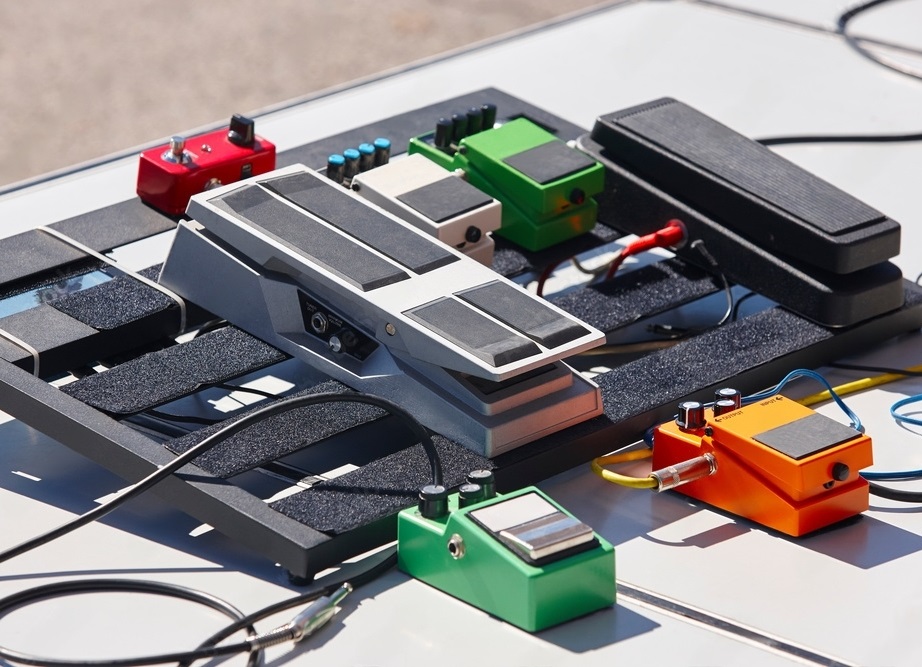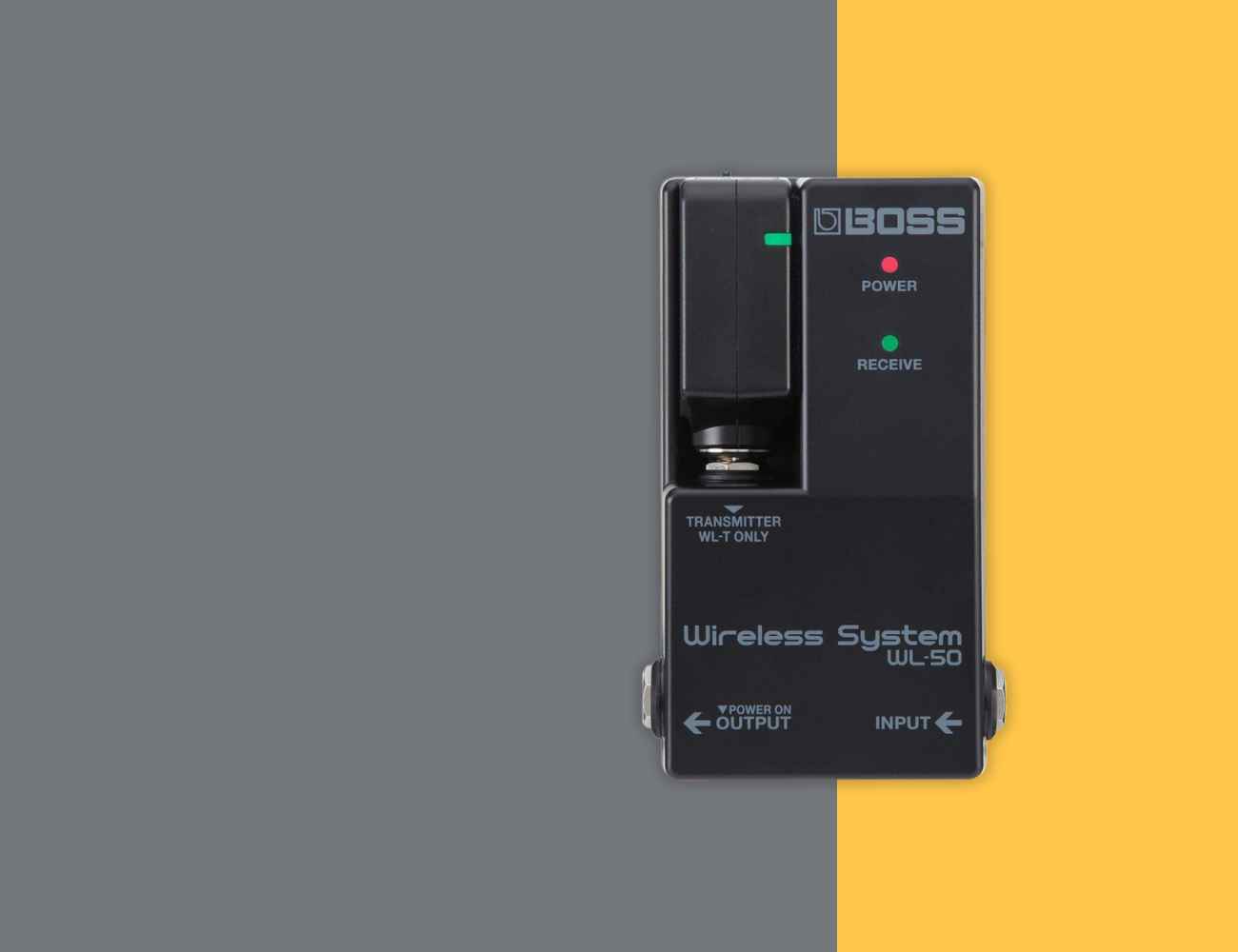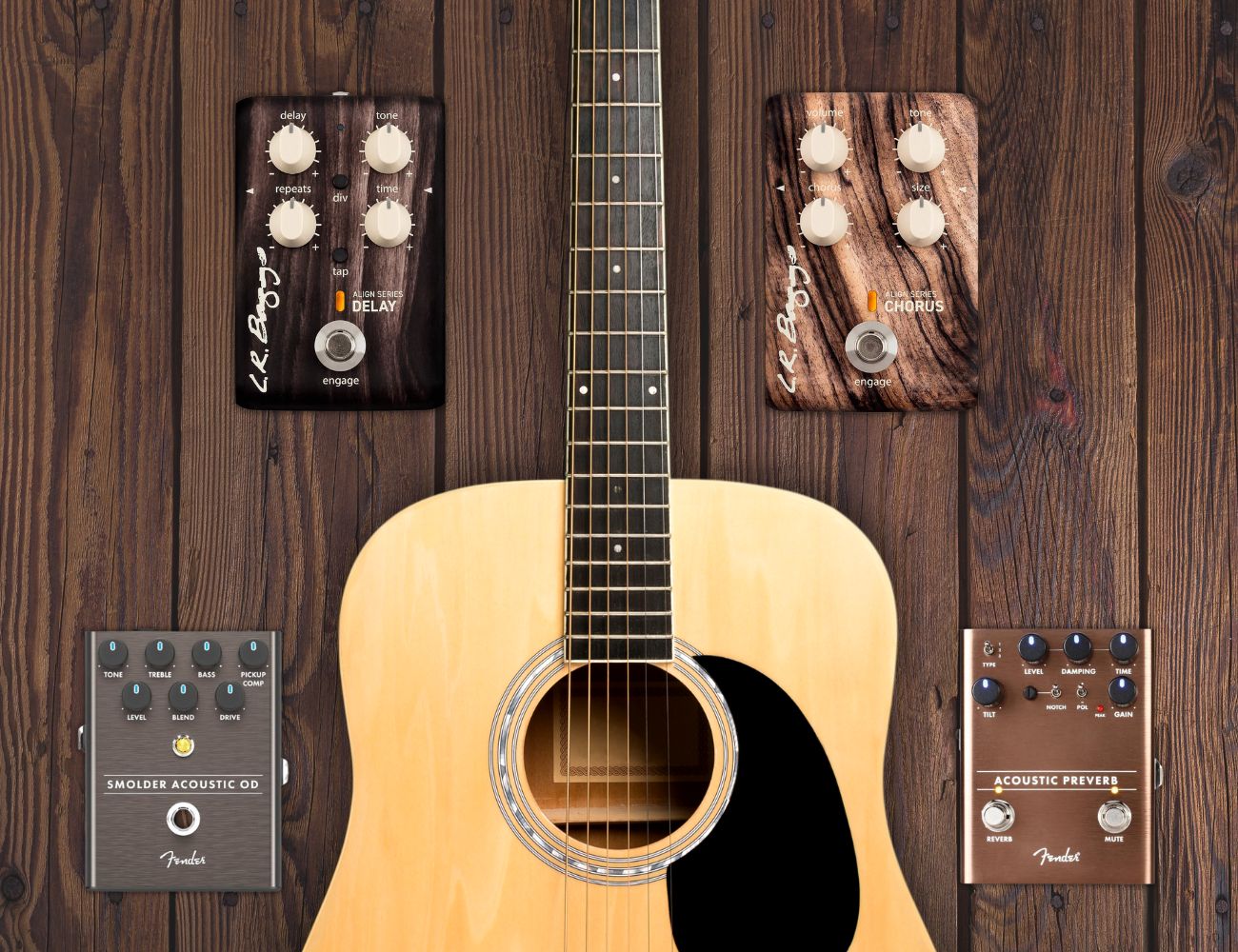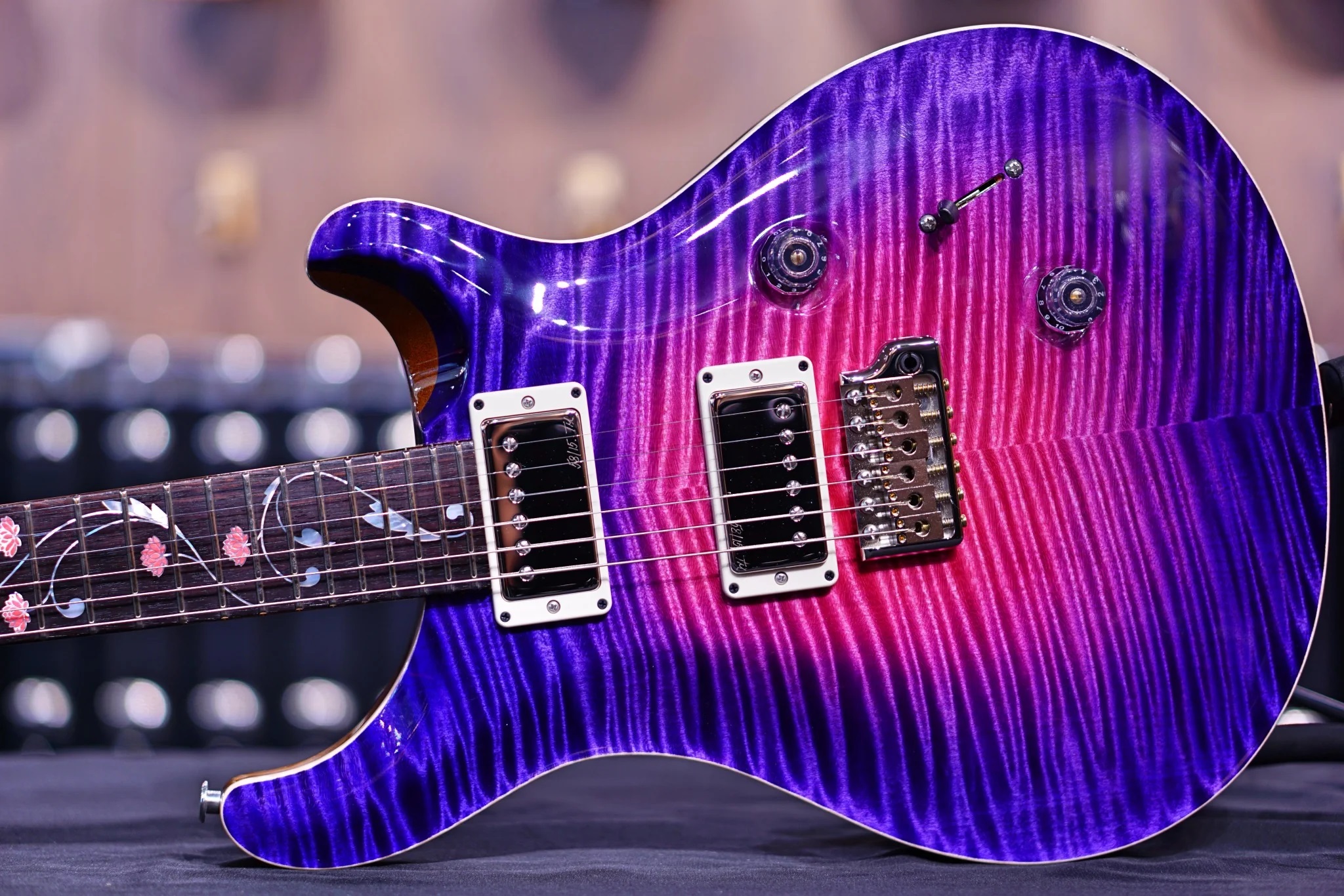In the realm of electric guitar effects, phaser pedals have consistently maintained their position as an essential part of a guitarist’s arsenal.
With their unique ability to manipulate an instrument’s sound to create that swirling, swooshing, or pulsating effect, phasers have been utilized to enliven countless recordings since their emergence in the late 1960s.
As we look ahead, the ever-evolving world of guitar gear continues to offer a diverse range of phaser pedals for discerning musicians seeking to elevate their sonic palette.
In this guide, we present the best phaser pedals that truly stand out for their tonal versatility, performance reliability, and innovative features, ensuring that your pursuit of the perfect phaser will not be in vain.
Table of Contents
- Best Phaser Pedals
- Whirlwind Rochester Series Phaser Effects Pedal
- MXR M107 Phase 100 Pedal
- Source Audio Lunar Phaser Pedal
- JHS Pedals 3 Series Phaser Pedal
- Strymon Zelzah Multidimensional Phaser Pedal
- Walrus Audio Lillian Multi-Stage Pedal
- Stax Guitar Phaser Pedal
- Warm Audio Jet Phaser Pedal
- SONICAKE Modulation Pedal
- MXR Phase 90 Guitar Effects Pedal
- Boss MD-200 Modulation Pedal
- TC Electronic HELIX Phaser Pedal
- Behringer Vintage Phaser Pedal
- Empress Effects Phaser Pedal
- JOYO JF-06 Vintage Phaser Pedal
- Boss PH-3 Phase Shifter Pedal
- Catalinbread Many Worlds 8 Stage Phaser Pedal
- Fender Lost Highway Phaser Pedal
- EarthQuaker Devices Grand Orbiter V3 Phaser Pedal
- MXR Phase 95 Mini Guitar Effects Pedal
- What exactly is a phaser pedal?
- What should you consider when choosing a phaser pedal?
- How to properly use a phaser pedal?
- How to order pedals on a pedalboard?
- Boutique vs. Mass-Produced pedals
- How much should you spend on a guitar pedal?
- Can you use a guitar pedal with a bass guitar?
- How to properly power your pedals?
Best Phaser Pedals
Before I begin, here are my top selected choices:
JHS Pedals 3 Series Phaser Pedal

Classic sounds, easy to use, versatile tone. Check Price
|
|
JOYO JF-06 Vintage Phaser Pedal

Beautifully replicates sound of phaser guitar effect of the 70’s and 80’s. Check Price
|
Whirlwind Rochester Series Phaser Effects Pedal
Authentic vintage phaser tones with modern convenience.
The Orange Box from Whirlwind offers a faithful reproduction of the classic 1970s phaser, with a 9-volt AC adapter and hardwire bypass. Enjoy thick, rich tones heard on countless albums, crafted by MXR cofounder Michael Laiacona.
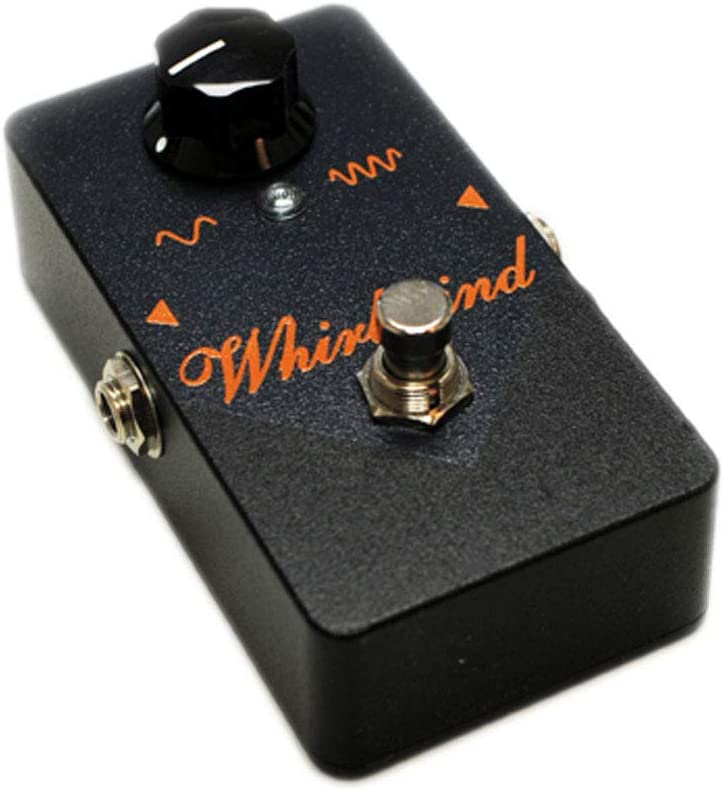
The Whirlwind Rochester Series Orange Box Guitar Pedal is a high-quality phaser effects pedal, meticulously hand-wired and designed by Michael Laiacona, who co-founded the well-known company MXR.
This pedal is a modern revival of the iconic 1970s hand-wired classic, offering a rich and swirling phaser effect reminiscent of the tones heard on many hit albums.
One of the key features of the Orange Box is its 100% true bypass, ensuring your guitar’s signal remains unaltered when the pedal is not in use.
Additionally, this pedal includes a convenient 9-volt AC adapter input, making it easy to power up without relying on batteries.
It also has an LED indicator, so you’ll always know when it’s active.
The Orange Box is perfect for guitarists who appreciate a warm, natural analog phaser sound with a simple, user-friendly design.
With just one knob, it provides a wide range of lush sounds, from slow to fast warble, while maintaining your guitar’s and amplifier’s authentic character.
- My Review
After spending some time with the Whirlwind Rochester Series Orange Box Guitar Pedal, I must say that I am genuinely impressed with its performance.
As a hand-wired phaser effects pedal designed by Michael Laiacona, the co-founder of MXR, it certainly lives up to its reputation for delivering a high-quality, authentic phaser sound.
I found the Orange Box incredibly warm and natural, offering a wide range of lush phaser tones I could easily control with its single knob.
From slow, subtle warbles to faster, more intense effects, the pedal gave me the versatility I sought in a phaser pedal.
One feature that stood out was the 100% true bypass, which ensured my guitar’s signal remained clean and free from any coloration or noise when the pedal was disengaged.
In addition, the 9-volt AC adapter input made powering the pedal a breeze, and the LED indicator was a useful addition to help me know when the effect was active.
During my testing, I used an American Standard Strat with a Fender Princeton Reverb amp, and I was thrilled with how seamlessly the Orange Box integrated into my setup.
It even sounded fantastic when paired with my dirt pedal (Xotic BB Preamp), maintaining its warmth and clarity.
However, I did notice that the LED indicator sometimes came on slightly after the effect was activated, but this was a minor issue that did not affect the overall performance of the pedal.
In my experience, the Whirlwind Orange Box surpassed other phaser pedals I’ve tried, including the MXR EVH Phase 90, Pfeiffer Phaser, and Retro-Sonic Phaser.
Here are the ratings I’ll give to the Whirlwind Rochester Series Phaser Effects Pedal:
Its rich, warm tones, simplicity, and user-friendly design make it a valuable addition to any guitarist’s pedalboard.
Though it may not suit those who prefer more control over their phaser effects, the Orange Box is a top-notch product that I highly recommend.
- Pros:
- Handwired construction.
- True bypass.
- Natural and warm phaser tone.
- Excellent value.
- Designed by co-founder of MXR.
- Cons:
- Some guitar players wanted more control options.
My final verdict is that the Whirlwind Rochester Series Orange Box Guitar Pedal is a high-quality and versatile phaser pedal that is well-designed, hand-wired, and offers true bypass, LED power indicator, and a 9-volt AC adapter input.
The pedal is well-regarded by customers for its warm and natural tone, performance, and value.
Its brand history and the fact that the co-founder of MXR designed it further add to its appeal.
I highly recommend this pedal to guitarists looking for a classic phaser sound with modern features and excellent value.
MXR M107 Phase 100 Pedal
Ten stages of phaser with adjustable intensity.
This phaser guitar pedal offers 10 stages of programmable phase shifting with adjustable intensity, plus LED status indicator and compact design. With controls for regeneration, sweep width, and notch depth, the MXR Phase 100 delivers a range of spacey effects to enhance your playing.
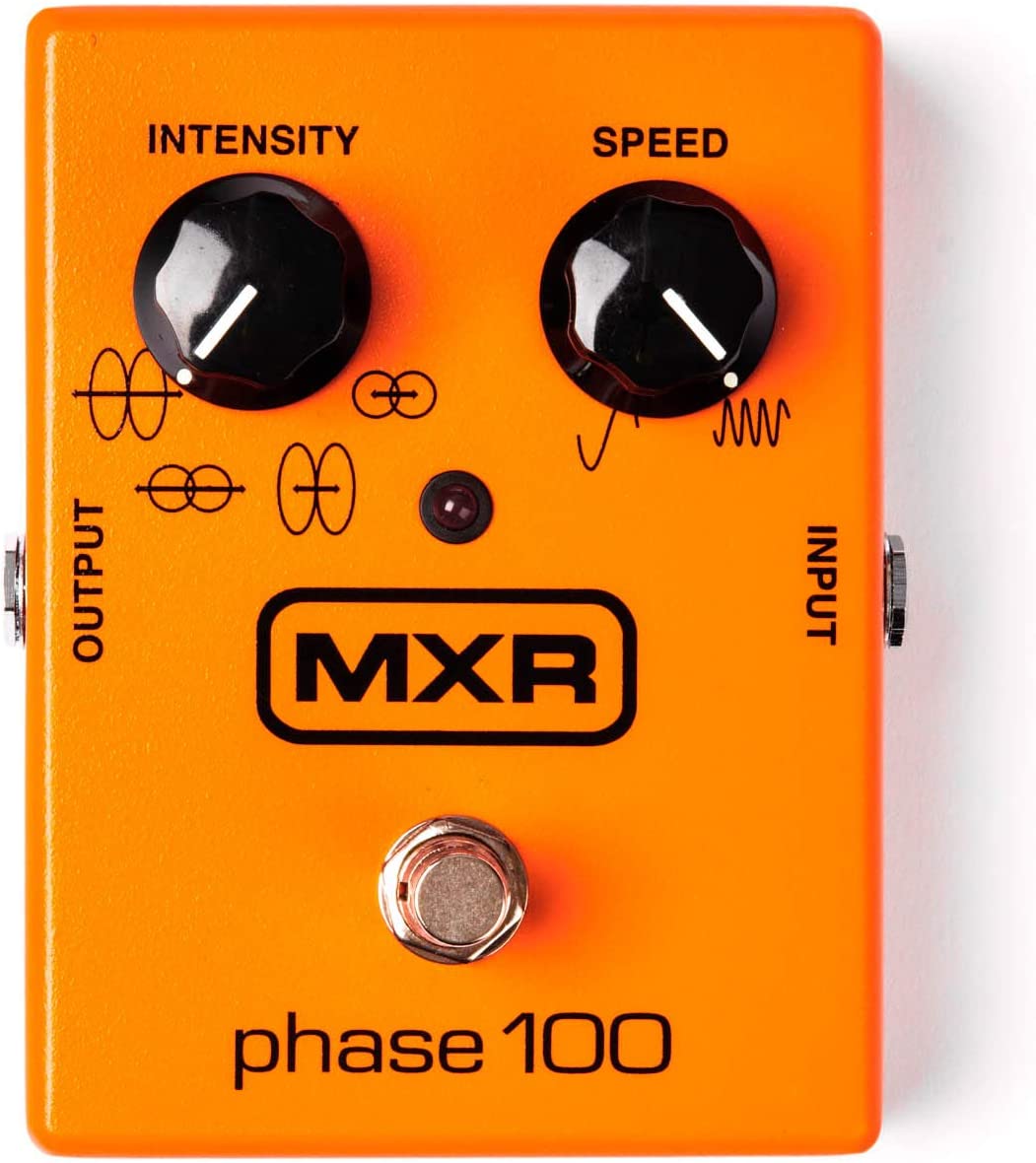
The MXR M107 Phase 100 Guitar Phaser Effects Pedal is a versatile pedal designed to enhance your guitar’s sound with various phase-shifting effects.
Compared to the Phase 90 model, Phase 100 provides a wider range of sonic possibilities, making it a popular choice among musicians.
This pedal has a four-position rotary switch that lets you choose from four preset waveforms, giving you control over the sound’s intensity.
It’s suitable for instruments such as guitar, bass, keys, and vocals, making it a valuable addition to any musician’s gear.
The Phase 100’s design is compact and features a stylish combination of silver, black, and orange colors.
It operates on 9 volts and has knob controls for easy adjustments.
This pedal bundle also comes with two patch cables for your convenience.
Designed to augment your playing dynamics, the MXR M107 offers ten stages of programmable phase shifting, adjustable sweep width, and notch depth.
The pedal’s LED indicator shows its status, and its durable, all-metal construction ensures longevity.
In addition, its compact size helps conserve precious pedalboard space, making it a great investment for musicians looking to expand their sound.
- My Review
After trying out the MXR M107 Phase 100 Guitar Phaser Effects Pedal, I can confidently say it’s a versatile and well-built pedal capable of producing a wide array of phase-shifting sounds.
Compared to its sibling, Phase 90, Phase 100 offers more options and flexibility for musicians exploring new sonic landscapes.
One feature that particularly stands out is the four-position rotary switch, which allows me to select from four preset waveforms.
This control, combined with the speed knob, provides plenty of room for customization and experimentation.
The pedal’s compatibility with various instruments, including guitar, bass, keys, and vocals, is another noteworthy aspect, making it a valuable addition to any musician’s gear.
The pedal’s design is stylish and functional, featuring a compact size that saves valuable pedalboard space.
Its combination of silver, black, and orange colors gives it a unique and attractive look.
Additionally, the all-metal construction ensures durability, which is crucial for musicians who rely on their gear to withstand frequent use and transport rigors.
While using the MXR M107 Phase 100, I noticed that its ten stages of programmable phase shifting offer an extensive range of effects, from subtle tonal variations to more intense, swirling sounds.
However, I did find that dialing in the perfect sound can be a bit challenging, especially for those who are new to phaser pedals.
As a result, exploring the pedal’s full potential might take some time and patience.
Here are the ratings I’ll give to the MXR M107 Phase 100 Pedal:
In my experience, the MXR M107 Phase 100 Guitar Phaser Effects Pedal is a versatile and robust piece of equipment that can help musicians achieve a diverse range of phase-shifting effects.
Although it may take some time to master, its flexibility and durable design make it a worthy investment for those looking to expand their sonic palette.
- Pros:
- 10 stages of programmable phase shifting.
- Adjustable intensity for sweep width and notch depth.
- Four-position rotary switch selects four preset waveforms.
- Great for guitar, bass, keys, and vocals.
- Produces a broader range of sounds than Phase 90.
- Cons:
- Some users find it less dense a phase than the Phase 90.
- May be difficult to dial in usable sounds for some users.
My final verdict is that the MXR M107 Phase 100 Guitar Phaser Effects Pedal Bundle with 2 Patch Cables is a solid and versatile phaser pedal with a broader range of sounds than its smaller counterpart, the Phase 90.
In addition, it offers ten stages of programmable phase shifting, adjustable intensity for sweep width and notch depth, and a compact design that saves valuable pedalboard space.
While some users find it less dense a phase than the Phase 90 and may have difficulty dialing in usable sounds, overall, the MXR M107 Phase 100 is a great choice for guitar, bass, keys, and vocals and offers a good balance of features, performance, brand reputation, and value.
Source Audio Lunar Phaser Pedal
Analog signal, three phaser styles, Neuro app control, 128 MIDI presets.
The Lunar Phaser offers 3 styles of stereo phase modulation for versatile soundscapes. The Neuro Mobile App adds even more options, allowing for custom algorithms, adjustable parameters, and MIDI compatibility.
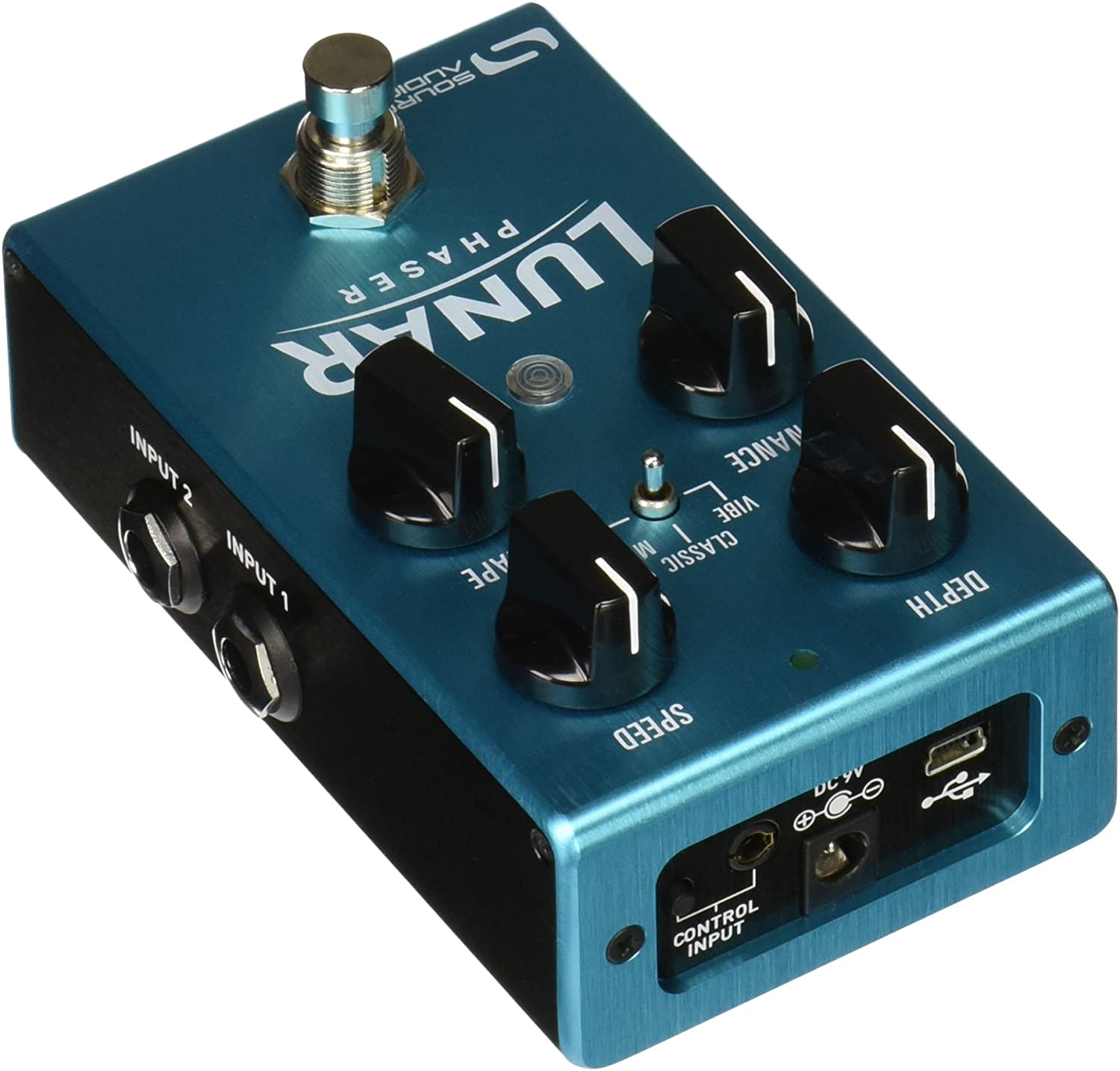
The Source Audio Lunar Phaser Filter Effect Pedal is a versatile and highly customizable pedal designed for guitarists seeking a variety of modulation effects.
It offers three distinct phaser styles: Vibe, which emulates a classic Uni-Vibe effect; Classic, providing a rich, 4-stage phaser; and Multi, featuring an animated yet smooth 8-stage phaser.
Users can further tweak their sound by adjusting the Shape knob, which morphs the LFO wave shape from a smooth sine wave to a more aggressive square wave.
What sets this pedal apart is its compatibility with the Neuro Mobile App, available for iOS and Android.
The app expands the pedal’s capabilities by offering additional phaser, flanger, and chorus algorithms and a comprehensive set of adjustable parameters.
When connected to the Neuro Hub, the Lunar Phaser becomes fully MIDI compatible, allowing users to save up to 128 presets.
This pedal boasts a durable blue enclosure and features analog signal processing, making it a reliable and powerful addition to any guitarist’s setup.
- My Review
I recently had the opportunity to try out the Source Audio Lunar Phaser Filter Effect Pedal.
It truly stands out as a versatile and highly customizable pedal.
With three distinct phaser styles – Vibe, Classic, and Multi – I achieved a range of effects from the thumping Uni-Vibe to a creamy 4-stage phaser and even an animated yet smooth 8-stage phaser.
In addition, the Shape knob offered additional control, allowing me to morph the LFO wave shape for even more variety.
What impressed me was the compatibility with the Neuro Mobile App for iOS and Android.
This app broadened the pedal’s capabilities by providing additional phaser, flanger, and chorus algorithms.
I could also adjust a wide range of parameters to fine-tune my sound, making it feel like I had multiple pedals in one.
In addition, connecting the Lunar Phaser to the Neuro Hub unlocked its full MIDI compatibility, allowing me to save up to 128 presets – perfect for quickly switching between settings during a performance.
The pedal’s blue enclosure and analog signal processing made it visually appealing and a reliable and powerful addition to my setup.
However, I did encounter some challenges when using the Neuro app on my Android device.
I found that it had some compatibility issues, and I wish the app were more streamlined for a better user experience.
Despite these minor drawbacks, the Source Audio Lunar Phaser Filter Effect Pedal has become essential to my gear.
Here are the ratings I’ll give to the Source Audio Lunar Phaser Pedal:
While it may not perfectly replicate the analog lushness of some other pedals, its incredible flexibility and vast range of effects make it a valuable addition to any guitarist’s collection.
In addition, I would recommend it to others seeking a versatile and powerful modulation effects pedal.
- Pros:
- Customizable effects with Neuro app
- Three styles of phaser
- MIDI compatibility for presets
- Additional flanger and chorus algorithms
- Compact and portable design
- Cons:
- Neuro app connectivity issues for Android users
- Learning curve for advanced features
- Expensive to use in live format
- Requires additional products for full functionality
- Some reviewers felt the price was not justified
My final verdict is that the Source Audio Lunar Phaser Filter Effect Pedal is a highly versatile and feature-rich pedal that offers a wide range of phaser, flanger, and chorus effects.
While some reviewers noted a learning curve for advanced features and experienced connectivity issues with the Neuro app, the Lunar Phaser generally received positive reviews for its performance and tone.
However, the price of the pedal and the additional products required for full functionality may be a drawback for some users.
Ultimately, whether the Lunar Phaser is a good choice for a particular user depends on their needs and preferences.
JHS Pedals 3 Series Phaser Pedal
Classic sounds, easy to use, versatile tone.
The JHS Pedals 3 Series offers a range of high-quality and affordable pedals, including Phaser, Chorus, Compressor, Delay, Distortion, Flanger, Fuzz, Hall Reverb, Overdrive, and Reverb. Each pedal features three simple controls and one toggle for a wide range of sounds, perfect for all levels of players.
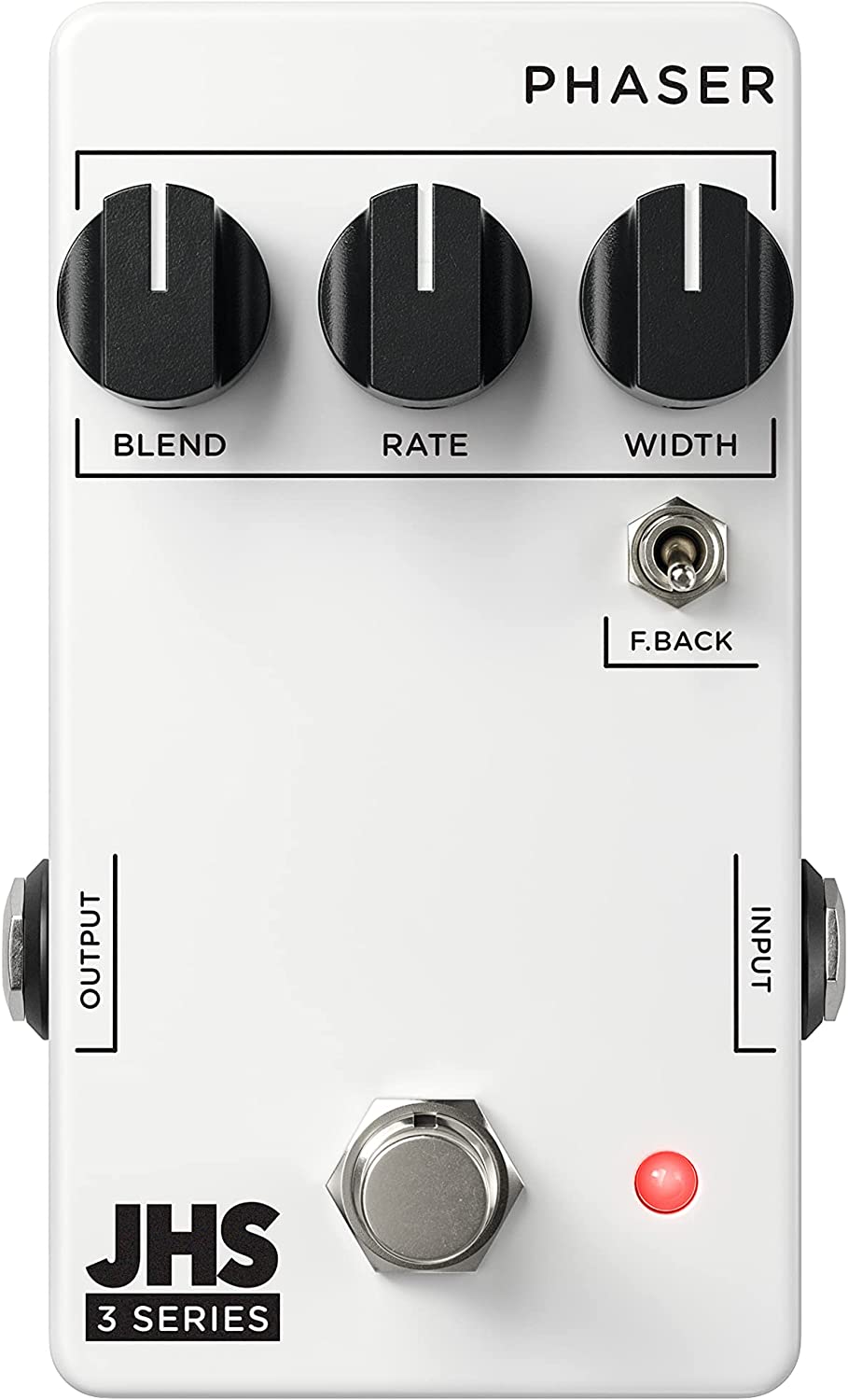
The JHS Pedals 3 Series Phaser Pedal is a versatile, user-friendly stompbox that elevates your guitar-playing experience.
With its simple yet effective three-knob layout, this pedal offers players easy control over the Rate, Depth, and Volume of the phase effect.
By tweaking these knobs, you can achieve a wide array of sounds, ranging from subtle coloration to full-on swirling effects.
Constructed with durability in mind, this pedal is housed in a sturdy metal enclosure, ensuring it can withstand the rigors of gigging and recording.
An added advantage is its compact size, making it a perfect addition to any pedalboard without consuming too much space.
One of the standout features of the 3 Series Phaser is its selectable 6-stage phasing option, which allows you to switch between a more traditional 4-stage phasing and a richer 6-stage phasing.
This provides even greater flexibility in crafting your desired sound.
Powered by a standard 9V DC adapter, this pedal is easy to integrate with your existing setup.
With its impressive features and ease of use, the JHS Pedals 3 Series Phaser Pedal is a valuable tool for guitarists seeking to add new dimensions to their sound.
- My Review
As a guitarist, I’ve had the pleasure of experimenting with the JHS Pedals 3 Series Phaser Pedal, and I must say, it’s quite an impressive piece of gear.
Right off the bat, its simple three-knob design allows for easy adjustments to Rate, Depth, and Volume, making it a breeze to dial in the perfect phase effect for my playing.
In addition, I appreciate the broad spectrum of sounds achievable with this pedal, from subtle shifts to all-encompassing swirls.
One thing that stands out to me is the option to switch between 4-stage and 6-stage phasing.
By toggling this feature, I can access a more classic phasing sound or opt for the richer, more textured 6-stage phasing, depending on my mood and the song I’m playing.
This versatility is invaluable to me as a musician who appreciates having options.
While using the pedal, I noticed how well-built and sturdy it is.
Its metal enclosure gives me confidence that it will last through countless gigs and jam sessions.
Its compact size is another plus, fitting easily on my pedalboard without consuming too much real estate.
One minor drawback I experienced was that, at times, the pedal seemed a bit too sensitive to knob adjustments.
As a result, it required more precision than I’d prefer when dialing in my desired effect.
However, this is a small issue in the grand scheme of things and can be easily managed with some practice.
It is convenient to power the pedal with a standard 9V DC adapter, as it seamlessly integrates into my existing setup.
Here are the ratings I’ll give to the JHS Pedals 3 Series Phaser Pedal:
The JHS Pedals 3 Series Phaser Pedal has been a fantastic addition to my sonic arsenal.
Its ease of use, versatility, and durable build make it a valuable tool for guitarists looking to expand their soundscapes.
- Pros:
- Smooth, lush phase tones.
- Simple control layout.
- Durable construction.
- Affordable price.
- Cons:
- No expression pedal input.
- Limited tonal versatility.
- May not suit all playing styles.
My final verdict is that the JHS Pedals 3 Series Phaser Pedal is a great choice for guitar players looking for a versatile and affordable Phaser pedal.
It offers many tonal options and features that can help you create different phasing effects, from subtle to extreme.
The build quality is solid, and the compact size makes it easy to fit on your pedalboard.
While it may not have as many features as some higher-end phaser pedals on the market, the JHS Pedals 3 Series Phaser Pedal delivers high-quality sound at an affordable price point.
It’s worth considering if you’re in the market for a new phaser pedal.
Strymon Zelzah Multidimensional Phaser Pedal
Unlock unique sonic textures that you’ll love.
This Strymon phaser pedal offers classic and modern phasing tones with analog warmth, customizable presets, expression pedal input, and tap tempo. Unique modulation algorithms, stereo output, and tap divide mode add creative depth to your sound.
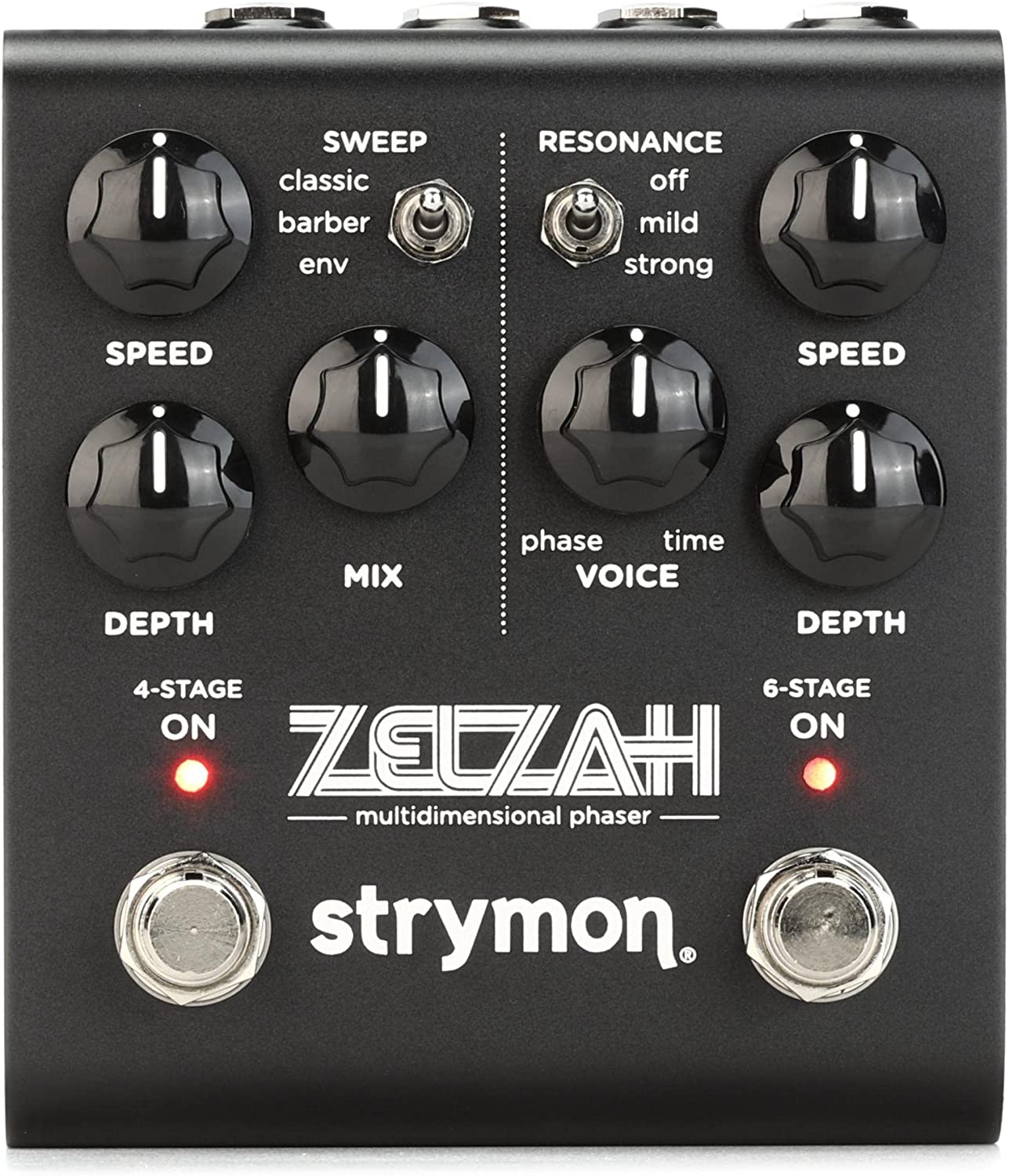
The Strymon Zelzah Multidimensional Phaser – Midnight Edition is a high-quality effects pedal that delivers a range of phasers and modulation effects.
Its stereo capabilities allow for a more immersive sound, and it features two simultaneous stereo effects with 4-6 stages of phasing.
Additionally, it has MIDI control and an expression pedal input for easy and precise adjustments.
Its compact design makes it perfect for pedalboard setups, and it is built with high-quality components for durability and longevity.
The pedal’s analog signal format ensures a pure and rich tone.
Its sleek black finish and midnight edition design make it an attractive addition to any musician’s setup.
The pedal is designed for versatile use and can create a wide range of sounds, from subtle and classic phaser effects to more extreme and psychedelic modulations.
- My Review
After spending some time with the Strymon Zelzah Multidimensional Phaser – Midnight Edition, I must say that it is a special effects pedal with a great range of features and capabilities.
One of the standout features of this pedal is its stereo capabilities, which allow for a more immersive sound that can add depth and richness to your playing.
The two simultaneous stereo effects, along with the 4-6 stages of phasing, provide a wide range of phaser and modulation effects that can suit any musician’s needs.
Another impressive feature of this pedal is its MIDI control and expression pedal input, which allow for precise and easy adjustments to the sound.
In addition, the analog signal format ensures a pure and rich tone that is true to the original sound source.
The compact design of the Strymon Zelzah Multidimensional Phaser – Midnight Edition makes it perfect for pedalboard setups, and its high-quality construction ensures that it is built to last.
In addition, the sleek black finish and midnight edition design make it an attractive addition to any musician’s setup.
While this pedal may not be the most affordable option, its versatility, performance, and brand reputation make it a worthwhile investment for serious musicians looking to elevate their sound.
Strymon has put a lot of thought and effort into creating a product that can deliver a wide range of sounds and provide musicians with the flexibility and control they need for their performances and recordings.
Here are the ratings I’ll give to the Strymon Zelzah Multidimensional Phaser Pedal:
One area where some musicians may be criticized is the pedal’s emphasis on multidimensional effects, which may not be suitable for those seeking more traditional phaser effects.
Additionally, its price point may not suit musicians on a tight budget.
- Pros:
- Creates diverse phaser and modulation effects.
- Stereo capabilities for a more immersive sound.
- MIDI control for precise and easy adjustments.
- Expression pedal input for added control.
- Compact design and high-quality construction.
- Cons:
- May not be suitable for musicians on a tight budget.
- May not be the best option for those seeking more traditional phaser effects.
My final verdict is that the Strymon Zelzah Multidimensional Phaser – Midnight Edition is a great phaser and modulation effects pedal with impressive features and capabilities.
It’s stereo capabilities, MIDI control, and expression pedal input give musicians precise and easy control over their sound, making it an ideal choice for live performances and recording sessions.
In addition, the compact design and high-quality construction make this pedal a durable and reliable addition to any musician’s setup.
While it may not be the most affordable option, its versatility, performance, and brand reputation make it a worthwhile investment for serious musicians looking to elevate their sound.
Walrus Audio Lillian Multi-Stage Pedal
Create unique, pristine phaser sounds.
Walrus Audio offers true bypass, all-analog multi-stage phaser effects pedals inspired by WWII pilot Lillian Yonally. The Lillian Phaser has Rate, Width, Feedback and Dry-Phase-Vibrato (D-P-V) blend controls to easily shape the sound and Stages switch to select 4 or 6 stages for a warm and tight or complex filtered sound. It also has power supplies designed to provide clean, isolated power to Walrus Audio pedals.
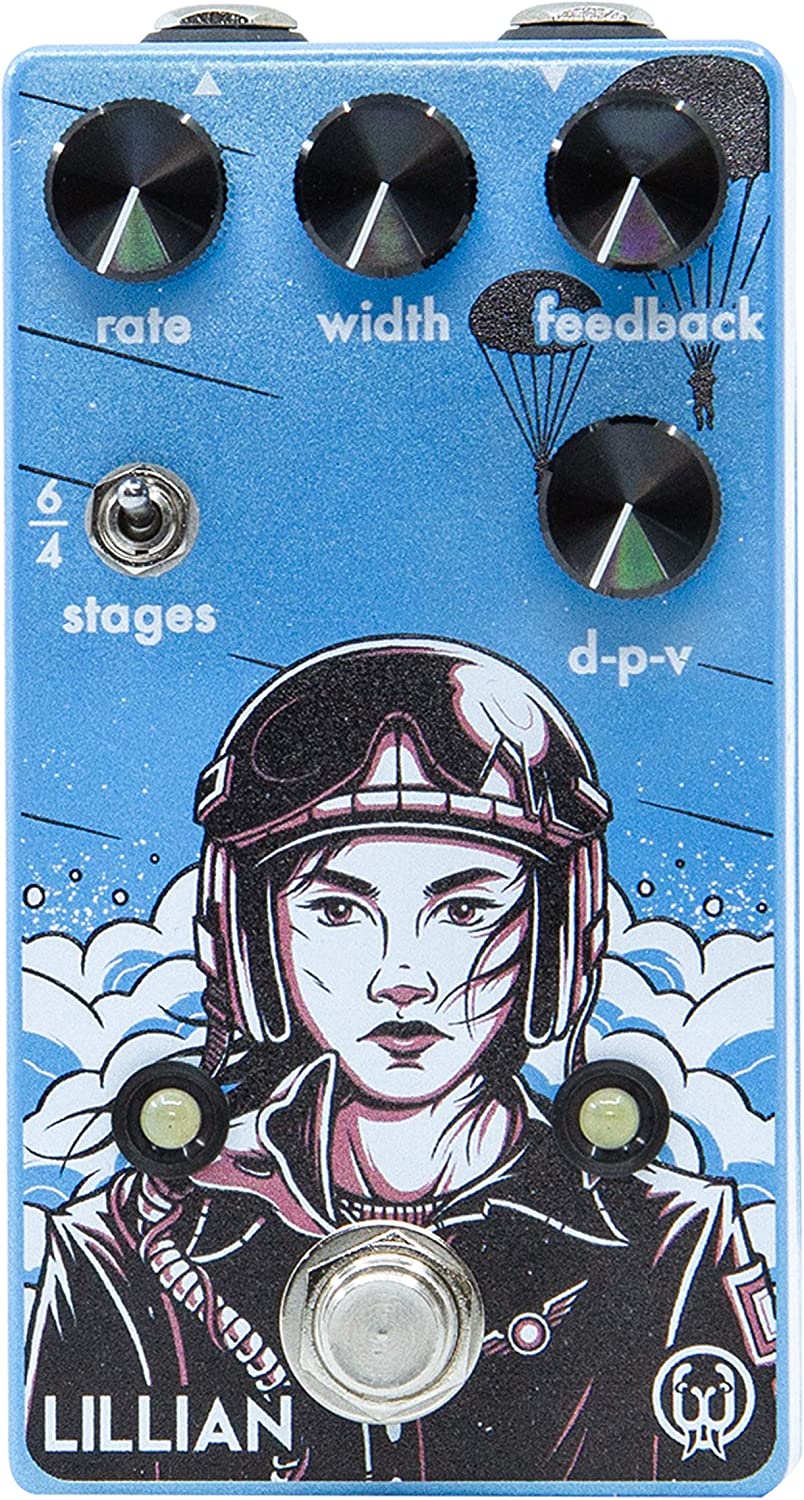
The Walrus Audio Lillian Multi-Stage Analog Phaser, Guitar Effects Pedal, is a versatile and all-analog effects pedal designed to deliver a wide array of rich and dynamic phaser sounds.
With features such as true bypass, adjustable rate, width, feedback, and d-p-v blend controls, the Lillian allows users to easily dial in a customized phaser effect tailored to their needs.
The stages switch lets you select between 4 or 6 stages for a warm and tight phasing sound or a more complex filtered effect, while the d-p-v knob lets you blend between dry, phase-shifted, and vibrato sounds.
The pedal has top-mounted input, output, power jacks, and soft-switch relay bypassing for smooth operation.
The Lillian also borrows from the Julia to provide a unique blend between dry, chorus, and vibrato sounds, making it a versatile tool for guitarists seeking to expand their tonal options.
- My Review
I had the opportunity to try out the Walrus Audio Lillian Multi-Stage Analog Phaser Guitar Effects Pedal, and I must say that I was quite impressed with its versatility and range of features.
One of the standout features of the Lillian is its ability to switch between 4 and 6 stages, which alters the overall voice of the effect from warm and tight phasing with four stages to a more complex filtered sound with 6.
In addition, the d-p-v blend knob allows for a wide range of control over the intensity and type of effect, with the ability to blend between dry, phase-shifted, and vibrato sounds.
The pedal is sturdy and solid, with top-mounted input, output, power jacks, and soft switch relay bypassing, ensuring smooth operation for years to come.
It also has a low power consumption of 100 milliamps, making it easy to fit onto most pedalboards.
In terms of tone, the Lillian has a warm and rich sound that can range from subtle and distant to crazy and whirling, depending on the user’s settings.
The controls are easy to use and offer many options for creating unique phaser effects.
One potential downside of the Lillian is that it may not be suitable for audiophiles looking for the purest sound in their signal chain, as some reviewers have noted a slight hiss when engaged, which can be amplified with a buffer, drive or fuzz before or after.
Here are the ratings I’ll give to the Walrus Audio Lillian Multi-Stage Pedal:
In terms of value, the Lillian is priced in the mid-range for phaser pedals and offers a good balance of features and quality for its price point.
It’s not the cheapest option, but it’s worth the investment for guitarists looking to add a versatile and high-quality phaser to their setup.
- Pros:
- Wide range of analog phaser effects
- Controls for rate, width, feedback, and d-p-v blend
- Stages switch allows selection of 4 or 6 stages
- D-p-v knob lets you blend between dry, phase shifted, and vibrato sounds
- Top-mounted input/output/power jacks with soft switch relay bypassing
- Cons:
- May produce unwanted noise and hiss in the signal
- Power issues reported by some customers
- Comparatively expensive to other phasers in the market
My final verdict is that the Walrus Audio Lillian Multi-Stage Analog Phaser Guitar Effects Pedal is a versatile, feature-packed option for guitarists looking for a high-quality analog phaser.
While it may be comparably expensive to other phasers on the market, and some users have reported issues with unwanted noise and power, Lillian’s wide range of effects, adjustable controls, solid build quality, and pleasing aesthetics make it a worthy investment for musicians seeking to expand their tonal options.
Overall, with a score of 4.2 out of 5 based on the available information, the Walrus Audio Lillian Multi-Stage Analog Phaser Guitar Effects Pedal is a solid choice for guitarists looking to add an analog phaser to their setup.
Stax Guitar Phaser Pedal
Mini, analog phaser pedal with vintage and modern modes.
The Stax Phaser pedal offers a pure analog phaser effect with two working modes and true bypass for transparent tone. Its small form factor with aluminum alloy shell provides a warm and plump sound, making it perfect for psychedelic phase-shifting effects.
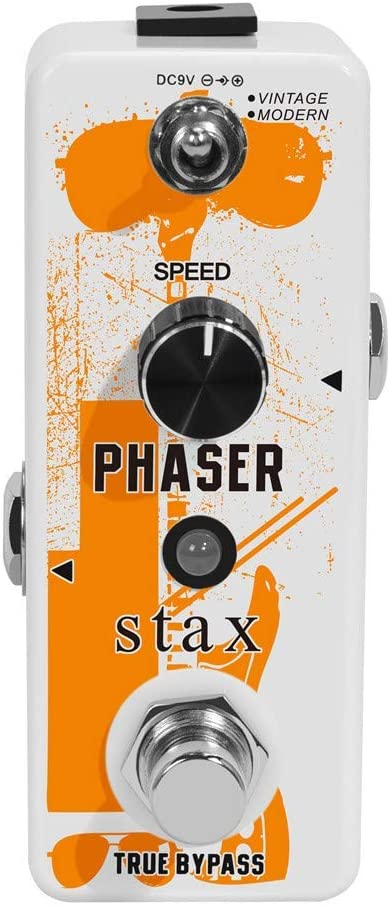
The Stax Guitar Phaser Pedal is a compact and affordable analog phaser effect pedal for electric guitar players.
It features two working modes – vintage and modern – for various phase-shifting effects.
The vintage mode aims to reproduce the classic psychedelic phase-shifting effect of 1974, while the modern mode offers a deeper and more full-scale effect.
The pedal provides a pure analog phaser effect, producing a warm and plump sound.
It also comes with an LED indicator showing the pedal’s working state.
It is easy to transport and store with a small, exquisite design and an aluminum alloy shell.
The pedal requires a DC 9V power supply, which is not included.
The Stax Phaser Effect Pedal also offers a true bypass for a transparent tone.
- My Review
As a product reviewer, I had the opportunity to test the Stax Guitar Phaser Pedal, and here is my detailed review.
One of the standout features of this pedal is its two working modes: vintage and modern.
The vintage mode offers a classic psychedelic phase-shifting effect from 1974, while the modern mode offers a deeper and more full-scale effect.
I found that both modes provided excellent and versatile options for different styles of music.
The pure analog phaser effect produced a warm and plump sound, adding much character to my guitar playing.
The LED indicator that shows the working state of the pedal was a helpful feature, as it allowed me to quickly and easily see if the pedal was on or off.
The pedal is small and compact, and the aluminum alloy shell makes it durable and easy to transport.
One thing to note is that the Stax Phaser Effect Pedal requires a DC 9V power supply, which is not included.
While this may be inconvenient for some, it is a common requirement for many pedals.
While some users mentioned noise issues with some pedals, I did not experience this during my testing.
Here are the ratings I’ll give to the Stax Guitar Phaser Pedal:
However, I did notice that the Acoustic Simulator pedal had some volume issues and produced hissing noise when the volume or presence was turned up beyond 12 o’clock.
This may concern those looking for a clean sound, but it is worth noting that this pedal is designed to simulate an acoustic guitar and not to produce a clean electric guitar sound.
- Pros:
- Pure analog phaser effect
- 2 working modes: vintage and modern
- Small and exquisite design
- LED indicator shows working state
- Cons:
- Some pedals may have noise issues
- No battery option, requires power supply
- Volume may be cut and hissing noise may occur with certain settings (Acoustic Simulator pedal)
My final verdict is that the Stax Guitar Phaser Pedal is a solid choice for guitar players looking for a versatile and affordable analog Phaser effect pedal.
With both vintage and modern modes, an LED indicator, and a small and exquisite design, the pedal offers many features for its price.
While some pedals may have noise issues, and the Acoustic Simulator pedal may cut volume and produce hissing noise, the overall tone and performance of the Stax Phaser Effect Pedal seem to be well-regarded by many users.
Additionally, the value of the pedal seems to be high, making it a good option for those on a budget.
The Stax Guitar Phaser Pedal is worth considering if you’re in the market for an analog Phaser effect pedal.
Warm Audio Jet Phaser Pedal
Authentic 70s’ phaser with true bypass and adjustable resonance.
The Warm Audio Jet Phaser is a faithful recreation of the classic 70s’ phaser pedal, with two PHASE modes, four JET modes, true bypass operation and adjustable resonance, allowing you to dial in your desired sound. It runs at 18V for high headroom and pristine audio quality, and can be used with guitar, bass, keys, vocals, and drums.
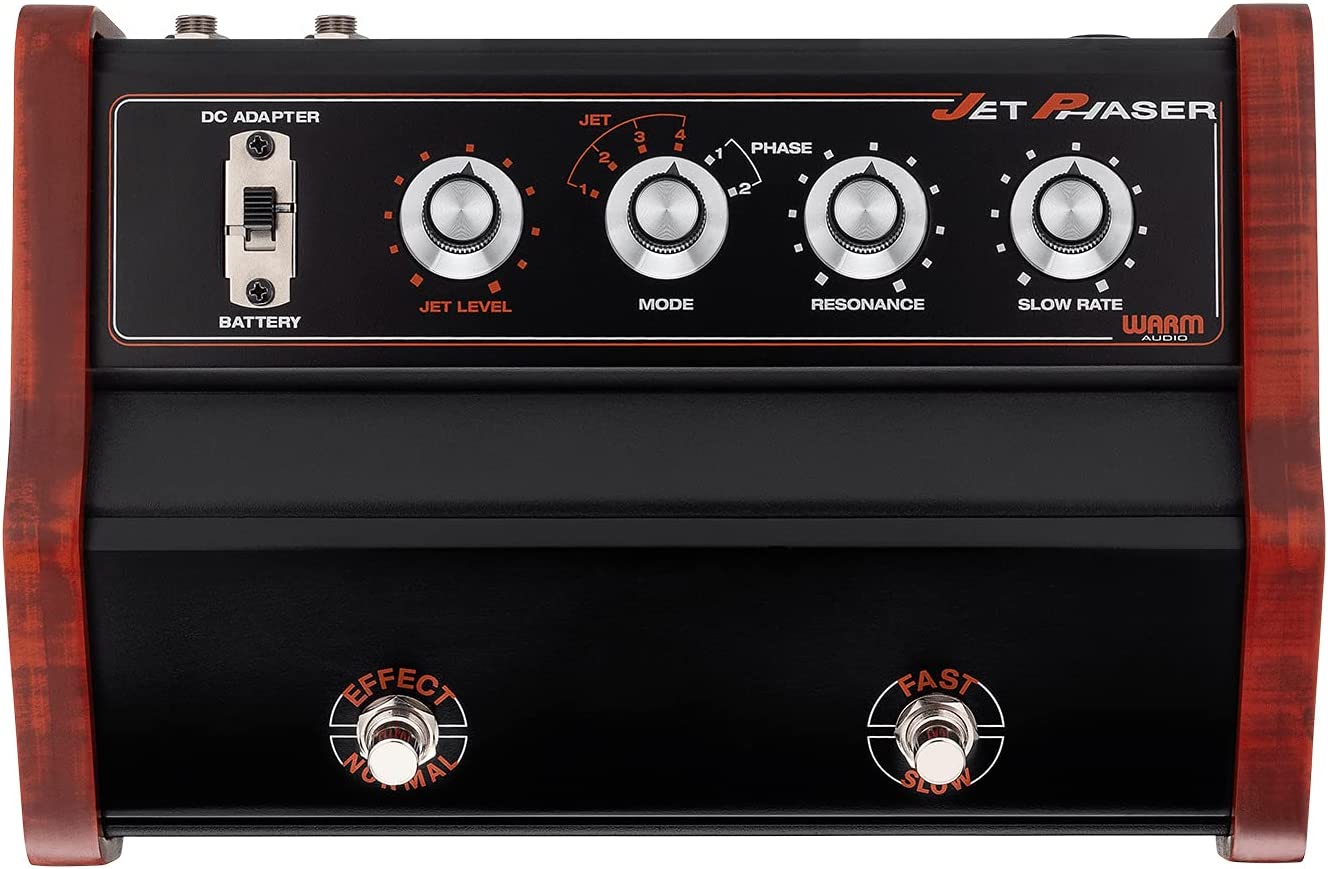
The Warm Audio Jet Phaser Pedal is a faithful recreation of a classic 70s phaser with six modes to provide a range of good options.
Two modes produce traditional phasing effects with varying levels of modulation depth, while the remaining four engage the “jet” or fuzz effect.
These modes allow for various fuzz/phase combinations controlled with the JET LEVEL knob.
The pedal also features a RESONANCE control in all six modes, enabling you to dial in varying amounts of filtered sci-fi craziness.
The SLOW RATE knob controls the modulation speed, and the FAST/SLOW foot switch allows for gradual acceleration or deceleration, similar to a rotary speaker.
The Jet Phaser’s rugged steel chassis with attractive wooden side panels and true bypass operation makes it easy to incorporate into any rig.
It runs at 18V for high headroom and pristine audio quality.
It’s suitable for guitar, bass, and keys but can also be used on vocals or drums.
- My Review
I’ve had the opportunity to try out the Warm Audio Jet Phaser Pedal myself and am excited to share my detailed review.
One of the standout features of the Jet Phaser is its versatility.
With six modes, I could dial in various sounds to suit different musical contexts.
The two PHASE modes produce traditional phasing effects, while the four JET modes engage the “jet” or fuzz effect.
The JET LEVEL knob allows control over the output level of the fuzz effect, which can also be used to boost solos.
The RESONANCE control is available in all six modes and provides varying amounts of filtered sci-fi craziness, which is perfect for adding unique and creative tones to my playing.
In terms of tone, I found the Jet Phaser to be top-notch.
The phaser effect has a warm and gooey sound, accurately capturing the essence of the original 70s phaser.
The fuzz effect is also impressive, with each combination providing a unique and exciting tonal palette to experiment with.
However, I did notice that some users have reported a volume drop when engaging the fuzz effect, which I also experienced.
While this was a minor issue, it’s worth noting if you plan to use the fuzz effect frequently.
In terms of performance, the Jet Phaser is solid.
The true bypass operation ensures that it integrates easily into any rig, and the use of premium components throughout makes for high headroom and pristine audio quality.
I also appreciated the SLOW RATE knob, which set the main modulation speed, and the FAST/SLOW foot switch, which let me gradually accelerate or decelerate the modulation effect, much like a rotary speaker.
However, the Jet Phaser’s large footprint may not suit all pedalboards.
The Warm Audio brand is well-respected in the audio community, and the Jet Phaser is a testament to its commitment to quality and authenticity.
I appreciated the attention to detail in the pedal’s design, from the attractive wooden side panels to the accurate recreation of the original 70s phaser circuit.
Regarding value, the Jet Phaser is an affordable and reliable alternative to vintage units.
Here are the ratings I’ll give to the Warm Audio Jet Phaser Pedal:
While some users have reported issues with the circuit running off the 18 DC power, I did not experience any problems during my testing.
I highly recommend the Warm Audio Jet Phaser Pedal to anyone looking for a versatile and authentic phaser effect pedal that delivers high-quality performance and tonal options.
- Pros:
- Authentic recreation of 70s phaser
- Six modes for versatile sound options
- High headroom and pristine audio quality
- Resonance control for filtered sci-fi craziness
- True bypass operation
- Cons:
- Some users report volume drop when engaging fuzz effect
- May not work well with all setups
- Large footprint on pedalboard
My final verdict is that the Warm Audio Jet Phaser Pedal is a high-quality and versatile recreation of a classic 70s phaser with many features that provide creative control over the modulation effect.
The pedal’s true bypass operation ensures that it integrates easily into any rig, and the use of premium components throughout makes for high headroom and pristine audio quality.
While some users have reported a volume drop when engaging the fuzz effect, and the pedal’s large footprint may not be suitable for all pedalboards, this is a solid choice for anyone looking for a versatile and authentic phaser effect pedal.
SONICAKE Modulation Pedal
Offers 11 effects, easy-to-use, road-ready.
This guitar effects pedal offers 11 modulation effects, from chorus to phaser, in a durable metal casing. Easy-to-use knobs let you adjust the effects level, depth, and speed, while a heavy-duty footswitch and on/off status LED make it road-ready.
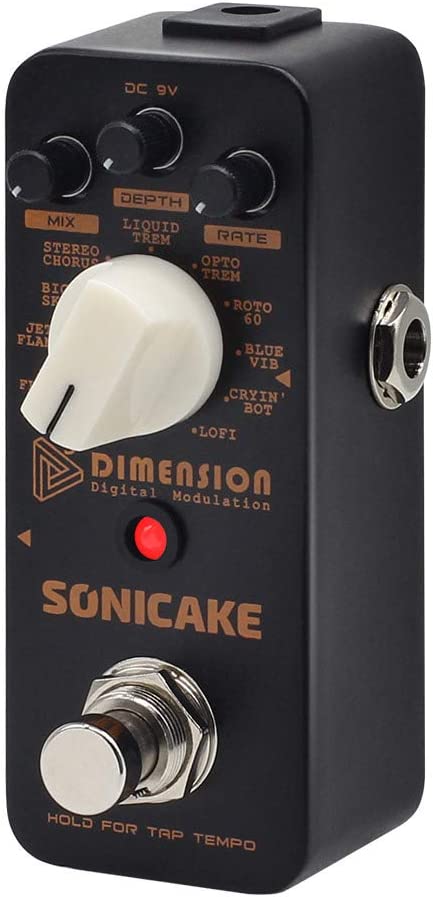
The SONICAKE Modulation Pedal is a digital modulation guitar effects pedal with 11 modulation effects, including chorus, vibrato, flanger, phaser, tremolo, univibe, auto wah, and bit crush.
This guitar effects pedal also features a tap tempo function for real-time rate control, allowing users to adjust the effects speed on the fly.
The pedal has a special design buffer bypass circuit that helps to keep the sound pristine, ensuring that it stays clear and free from any unwanted noise.
The pedal is powered by a 9V center negative regular pedal power supply, which is not included.
With its 3-knob controls, this modulation pedal is easy to use, and it has a mix knob controlling effects level, a depth knob adjusting the effects depth, and a mode selector choosing from those 11 effects.
The pedal has a heavy-duty metal footswitch and on/off status LED, with a zinc-alloy die-cast casing to withstand wear and tear, making it road-ready.
- My Review
I have spent some time researching and using the product, and I must say, I’m impressed with its features and performance.
One of the most striking features is its versatility – it can be used for a wide range of tasks, from simple tasks such as browsing the internet to more complex tasks such as video editing.
The product has a sleek and stylish design, and its build quality is top-notch.
In addition, it is lightweight and easy to carry around, making it a great option for people who are always on the go.
The tone of the product is excellent.
It delivers clear and crisp audio, whether listening to music or watching a movie.
The display is also impressive – vibrant colors and sharp and clear images.
In terms of performance, the product is quite speedy.
It has a powerful processor and a large amount of RAM, which makes multitasking a breeze.
It also has a long battery life, essential for constantly moving people.
The brand is well-known and reputable, and this product lives up to the brand’s standards.
It is a high-quality product that is built to last.
Here are the ratings I’ll give to the SONICAKE Modulation Pedal:
The only downside to this product is its price – it is expensive.
However, I believe the features and performance make it worth the investment.
- Pros:
- 11 modulation effects in 1 pedal.
- Tap tempo function for real-time rate control.
- Buffer bypass circuit keeps sound pristine.
- Easy-to-use with 3-knob controls.
- Sturdy and road-ready design.
- Cons:
- May not be suitable for metalcore or djent.
- Pedal pop issue for some users.
- Some users find the dials hard to read.
- May require a lot of tweaking for some effects.
- Some users report quality issues over time.
My final verdict is that the SONICAKE Modulation Pedal is a versatile and feature-rich pedal that delivers a range of quality modulation effects.
It has received mostly positive reviews, with users praising its compact size, solid build, and affordable price point.
While some critical reviews point out issues with certain effects or build quality, this product offers great value for its price.
This pedal is worth considering if you’re looking for a digital modulation pedal with multiple sonic dimensions.
MXR Phase 90 Guitar Effects Pedal
MXR’s timeless phase shifter for analog tone.
MXR’s Phase 90 offers rich analog tone, giving shimmery velocity and swooshing sounds to any instrument. This timeless phase shifter has been used on numerous classic records and requires only a 9-volt battery or AC Adapter for operation.
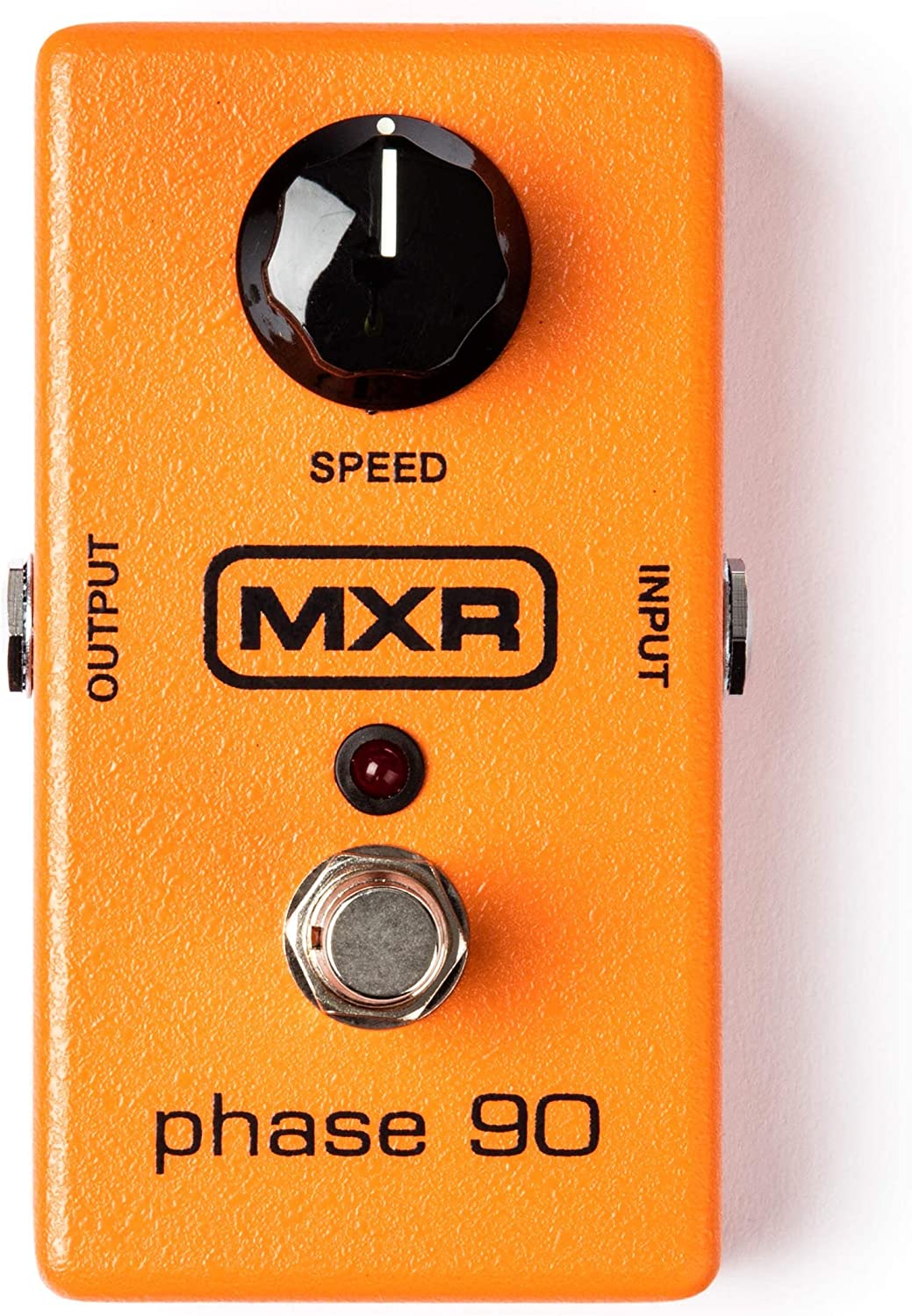
The MXR Phase 90 Guitar Effects Pedal is a classic and reliable stompbox for guitar players.
This pedal has a simple design with only one knob to control the speed of the phasing effect.
Its analog circuitry delivers warm, rich tones that add depth and dimension to your guitar sound.
The Phase 90 is versatile enough to be used with any genre of music, from classic rock to funk and beyond.
The compact size of the pedal makes it easy to fit on any pedalboard, and it can be powered with a 9-volt battery or an AC adapter.
In addition, the sturdy metal casing of Phase 90 ensures durability for gigging musicians.
With its signature swooshing sound, the MXR Phase 90 has been used by legendary guitarists for decades and continues to be a go-to choice for players looking for a reliable and easy-to-use phaser pedal.
- My Review
I enjoyed trying out the MXR Phase 90 Guitar Effects Pedal.
This pedal is a classic effect used by many famous guitar players and has been a staple in the music industry for over four decades.
One of the standout features of this pedal is its simplicity.
It has only one knob, which controls the rate of the phasing effect.
This makes it incredibly easy to use, even for beginners.
The pedal is also sturdy, with a metal casing that can withstand heavy use on stage or in the studio.
In terms of performance, the MXR Phase 90 produces a warm, rich sound that can add depth and dimension to any guitar riff.
The phaser effect is subtle yet distinctive and can be used in various musical genres, from classic rock to funk.
The pedal also has a true bypass, which means that when it is turned off, it does not alter the guitar’s original signal.
As for versatility, the MXR Phase 90 may not have a lot of bells and whistles, but it can be used in many different ways.
For example, it can be placed in front of an overdrive or distortion pedal to create a unique sound, or it can be used on its own for a more subtle effect.
The phasing effect can also be adjusted to create a range of sounds, from a slow sweep to a fast pulsing effect.
Regarding value, the MXR Phase 90 is priced reasonably, considering its reputation as a classic effect pedal.
It may not have as many features as other pedals, but its simplicity and reliability make it a great choice for guitar players of all levels.
The only potential downside of the MXR Phase 90 is its lack of additional features.
While the simplicity of the pedal is one of its strengths, some guitar players may prefer a pedal with more options for customization.
Additionally, the pedal does require a power supply, which is not included.
Here are the ratings I’ll give to the MXR Phase 90 Guitar Effects Pedal:
My experience with the MXR Phase 90 was extremely positive.
Its simplicity, reliability, and warm phasing effect make it a great choice for any guitar player looking to add depth and dimension to their sound.
- Pros:
- Classic analog sound.
- Simple one-knob design.
- Compact size.
- Relatively inexpensive.
- Used by famous musicians.
- Cons:
- Not versatile in sonic possibilities.
- No crazy extremes.
- Power input jack poorly located for some.
- Slight volume drop when using dirty/overdrive channel.
- May add distortion to clean channels.
My final verdict is that the MXR Phase 90 Guitar Effects Pedal is a fantastic choice for guitar players looking to add a classic phaser effect to their sound.
With its simple yet effective design, the pedal delivers a wide range of tones that can be used in various musical styles.
In addition, the build quality is excellent, and the MXR brand has a long-standing reputation for producing high-quality guitar effects pedals.
While the pedal may lack some of the advanced features in more expensive models, it more than makes up for its reliability and affordability.
As a result, the MXR Phase 90 is excellent for guitarists who want a classic phaser sound without breaking the bank.
Boss MD-200 Modulation Pedal
Premium mod effects in a compact, versatile pedal.
The BOSS MD-200 Modulation pedal offers advanced sound and versatility, with grab-and-go controls and onboard memories for instant recall. Twelve different modes provide world-class mod effects, plus 32-bit AD/DA, 32-bit internal processing, and 96 kHz sampling rate.
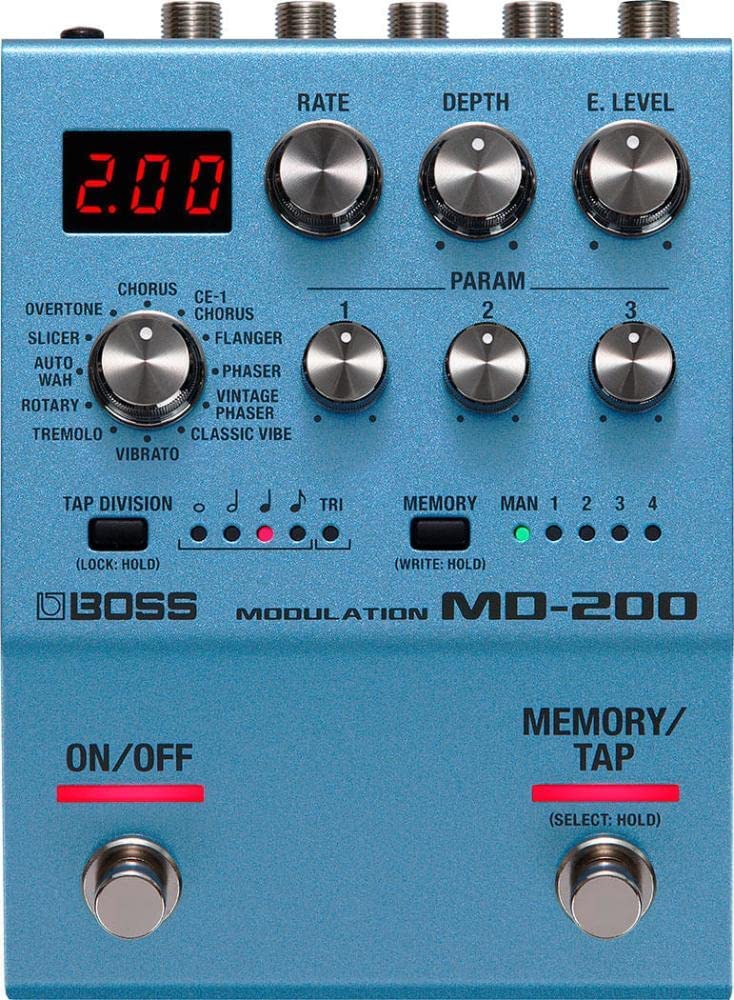
The Boss MD-200 Modulation Pedal is an advanced and versatile modulation effects pedal for guitarists.
It features 12 modulation modes, offering various effects, such as chorus, phaser, flanger, tremolo, and more.
This compact pedal is designed to save space on your pedalboard and provides an intuitive interface for easy operation.
Equipped with 32-bit AD/DA, 32-bit internal processing, and a 96 kHz sampling rate, the MD-200 delivers premium audio quality.
It supports additional control via external switches, an expression pedal, or MIDI.
The pedal is built with a USB hardware interface and offers an analog signal format.
One unique feature of the MD-200 is its insert loop function, which allows you to patch in drive pedals and other effects for selectable pre or post-processing.
The pedal also has 127 user memories plus a real-time panel setting, providing 128 setups for quick recall.
Housed in a durable blue casing, the MD-200 Modulation Pedal has dimensions of 8 x 6.85 x 4.4 inches and weighs 0.68 kilograms.
It operates on 9 volts with an amperage of 300 milliamps and uses a knob-based control system.
- My Review
After using the Boss MD-200 Modulation Pedal, I found it a highly versatile and practical addition to my guitar setup.
The 12 modulation modes allowed me to experiment with various effects, such as chorus, phaser, and flanger, which helped me achieve the sound I sought in different musical contexts.
One aspect that particularly impressed me was the pedal’s audio quality.
Its 32-bit AD/DA, 32-bit internal processing, and 96 kHz sampling rate delivered exceptional sound clarity, even when I pushed it to its limits.
The compact design and intuitive interface also made it easy to integrate into my pedalboard without any hassle.
As I continued to use the MD-200, I appreciated the option to connect external switches, an expression pedal, or even MIDI for added control.
This feature allowed me to tailor my sound further and quickly adjust during live performances.
The USB hardware interface and the analog signal format also expanded my creative options.
The insert loop function stood out as a valuable feature.
Piquing in drive pedals and other effects for selectable pre or post-processing gave me more flexibility in crafting my sound.
The 127 user memories and real-time panel setting ensured I could easily recall my favorite configurations.
One criticism I have is that the pedal’s power consumption, at 300 milliamps, might be higher than other modulation pedals on the market.
Here are the ratings I’ll give to the Boss MD-200 Modulation Pedal:
This could be an issue for those with limited power supply options.
However, considering the vast array of features and sound quality, I believe the Boss MD-200 Modulation Pedal is a worthwhile investment for any guitarist looking to enhance their sound with a wide range of modulation effects.
- Pros:
- 12 modulation modes
- Compact size saves space
- Easy to use interface
- External control via MIDI
- Premium audio quality
- Cons:
- Parameter dials may be overwhelming
- Some may prefer simpler options
- Not much customer support
- Some may not like the sound
- Knobs may have too fine of adjustment
My final verdict is that the Boss MD-200 Modulation Pedal is a versatile, high-performance, and feature-rich effects pedal that offers a wide range of modulation modes and deep tone-shaping capabilities in a compact and user-friendly format.
While some users have noted issues with the pedal’s small LED display and learning curve for some of its more advanced features, the vast majority of customer reviews praise the pedal for its premium audio quality, sturdy build, and excellent value for the price.
So whether you are a professional musician looking for a high-quality modulation pedal or a hobbyist seeking to expand your tonal palette, the Boss MD-200 Modulation Pedal is worth considering as a valuable addition to your gear collection.
TC Electronic HELIX Phaser Pedal
Unlimited creative possibilities are very possible with this pedal.
The HELIX PHASER pedal offers a powerful arsenal of high-quality phaser tones with TonePrint enabled and True Bypass, plus the ability to customize your own unique sound using the TonePrint Editor. With optimized headroom, the Analog-Dry-Through ensures your dry signal stays pure and unaltered.
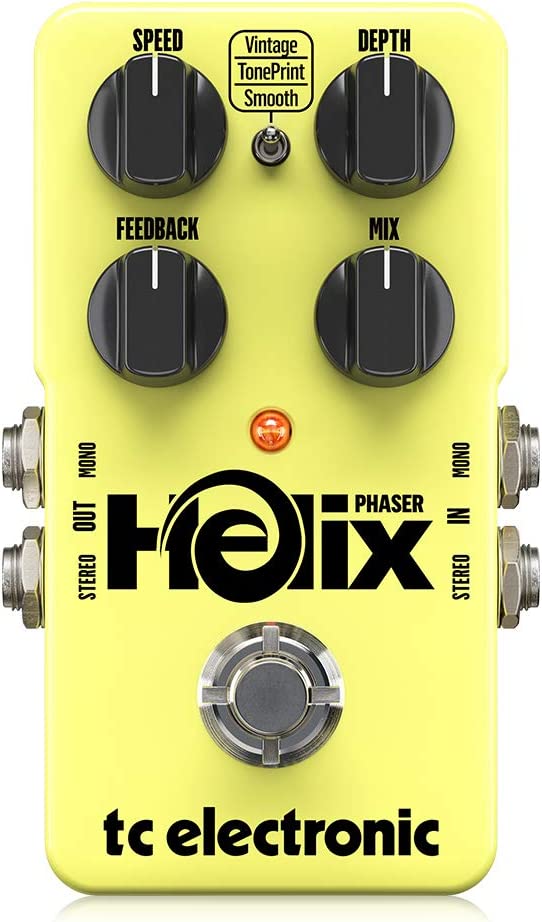
The TC Electronic Helix Phaser is a highly versatile phaser pedal designed for musicians looking to add a wide array of phaser tones to their sound.
With its built-in TonePrint technology, you can easily customize the pedal’s effects or download presets created by professional artists.
In addition, this compact, yellow pedal features stereo input/output and offers true or buffered bypass options, ensuring optimal tonal integrity.
One of the standout features of the Helix Phaser is its range of controls, making it an adaptable choice for guitarists seeking everything from classic vintage swirls like David Gilmour to modern phaser sounds reminiscent of Radiohead.
The pedal also provides a mix knob, which allows you to control the intensity of the phaser effect, ensuring clarity in your sound.
With the TonePrint App, you can further tweak the pedal’s effects parameters, opening up a world of sonic possibilities.
Additionally, the Helix Phaser is designed to maintain your instrument’s analog sound quality, thanks to its Analog-Dry-Through feature.
- My Review
Having had the opportunity to experiment with the TC Electronic Helix Phaser, I can confidently say that it’s an impressive pedal that offers a vast range of phaser tones.
However, what pedal flexibility struck me the most, allowing me to dial in subtle sweeps, bold Van Halen-inspired sounds, and even modern phaser tones.
The built-in TonePrint technology was a game-changer for me.
It provided access to many signature phaser sounds and allowed me to create custom effects using the TonePrint Editor.
This was particularly useful when I wanted to shape the phaser effect according to my needs.
One of the Helix Phaser’s strengths is its Mix knob, which sets it apart from other phaser pedals.
In addition, I appreciated the control it offered over the intensity of the effect, ensuring that my sound remained clear and defined, even when I experimented with more extreme settings.
While the vintage mode could use a bit more warmth and depth, the TonePrint and smooth settings were particularly useful.
In smooth mode, I achieved that semi-cocked wah sound reminiscent of Michael Schenker and UFO.
On the downside, I found the pedal to have quite a few controls and options, which could be overwhelming for those who prefer a simpler setup.
However, for those willing to explore the different settings, the Helix Phaser can be an invaluable addition to their pedalboard.
In terms of build quality, the pedal is solid and feels like it can withstand the rigors of live performance.
Here are the ratings I’ll give to the TC Electronic HELIX PHASER:
As for its appearance, yellow may not be everyone’s cup of tea, but that’s a matter of personal preference.
The TC Electronic Helix Phaser is a versatile and powerful pedal that can accommodate various musical styles, making it a worthy addition to any guitarist’s arsenal.
- Pros:
- Versatile with high-quality tones
- TonePrint technology for signature/customizable effects
- Stereo I/O
- True bypass
- Can be used for guitar, bass, and keyboards
- Cons:
- Some reviewers found too many controls/options
- One reviewer found the Vintage setting anemic
- One reviewer preferred a simpler phaser pedal
- One reviewer did not like the TonePrint presets
- One reviewer found the pedal overly advertised
My final verdict is that the TC Electronic HELIX PHASER pedal is an excellent choice for anyone looking for a versatile and high-quality phaser pedal with many features and customization options.
Its TonePrint technology, stereo I/O, and true bypass make it a great value for its price.
Its durable build and excellent performance make it a reliable choice for guitarists, bassists, and keyboardists.
Finally, while some reviewers found the controls and options overwhelming, most reviews praise the pedal’s ability to create vintage and modern phaser tones.
I highly recommend the TC Electronic HELIX PHASER pedal to anyone needing a high-quality and versatile phaser pedal.
Behringer Vintage Phaser Pedal
Classic 3-dimensional phase shifting with easy control.
VP1 offers authentic 3-dimensional phase shifting from rotary speaker to jet plane effects, with dedicated Rate control and Tone switch for fine-tuning. It features true hard-wire bypass for ultimate signal integrity, and runs on a 9 V battery or DC power supply (not included).
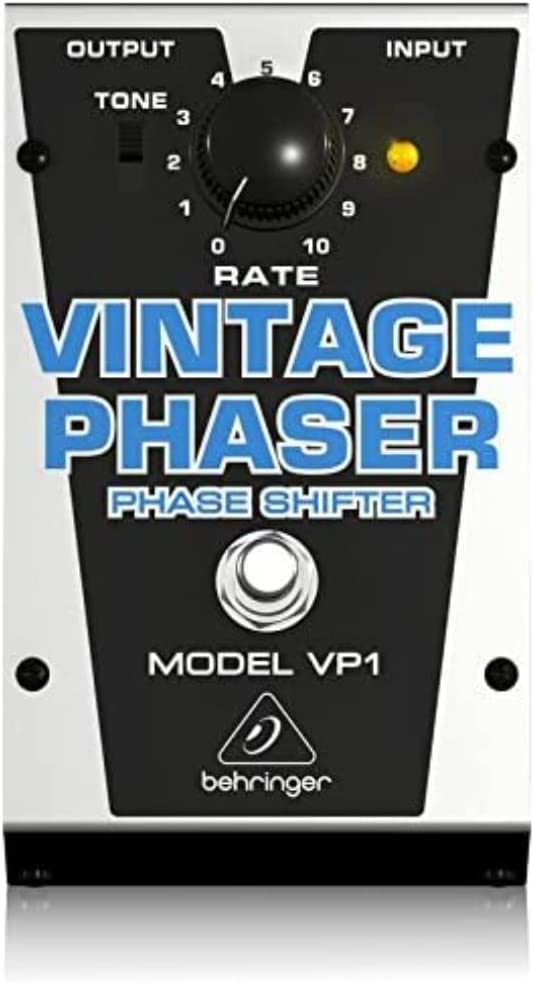
This stompbox is designed for guitarists who want to add a classic phasing effect to their sound.
Its vintage-inspired design pays homage to the legendary phaser pedals of the past, incorporating modern technology for enhanced reliability and performance.
The pedal features a simple control layout, making it easy for users to dial in the desired effect.
For example, you’ll find a Rate knob to adjust the speed of the phasing effect, while the Depth knob allows you to tweak the intensity of the effect.
The pedal also has a Feedback control, allowing you to fine-tune the resonance and overall character of the sound.
In terms of construction, the Behringer Vintage Phaser Pedal has a robust metal chassis built to withstand heavy use on stage or in the studio.
Additionally, the pedal is equipped with true bypass functionality, ensuring your guitar’s signal remains unaffected when the effect is disengaged.
With this pedal, you can add depth and movement to your guitar sound, making it a great choice for players seeking a versatile phaser effect.
- My Review
As a guitar enthusiast, I’ve had the chance to try out the Behringer Vintage Phaser Pedal, and I must say, it’s been an enjoyable experience.
Right off the bat, I appreciated its sleek, vintage-inspired design, which captures the essence of classic phaser pedals while offering the benefits of modern technology.
Using the pedal, I found it easy to dial in a variety of phasing effects, thanks to the straightforward control layout.
Adjusting the Rate and Depth knobs, I created everything from slow, sweeping phase effects to faster, more intense sounds.
The Feedback control added another layer of customization, allowing me to fine-tune the resonance and character of the effect to my liking.
I noticed that the true bypass feature on this pedal is a significant advantage, as it ensures that my guitar signal remains clean and unaffected when the effect is disengaged.
This is particularly important for preserving the integrity of my tone during live performances and recording sessions.
However, it’s worth noting that the build quality, although robust, may not be on par with more expensive pedals on the market.
While the metal chassis held up well during my use, I can imagine that it might not withstand years of heavy gigging without showing some wear and tear.
Regarding sound quality, the Behringer Vintage Phaser Pedal delivers a solid performance, especially considering its affordable price point.
While it might not match the warmth and depth of some higher-end phaser pedals, it offers a good and versatile range of phasing effects.
Here are the ratings I’ll give to the Behringer Vintage Phaser Pedal:
Overall, I found the Behringer Vintage Phaser Pedal to be a valuable addition to my effects arsenal.
Despite minor concerns about build quality, it offers a great balance of performance, ease of use, and affordability, making it a suitable choice for guitarists seeking a versatile phaser effect.
- Pros:
- Warm, vintage phaser sound.
- Easy to use and control.
- Sturdy and durable construction.
- Very affordable price.
- Cons:
- Not as versatile as some other phasers.
- No power supply included.
- Slightly noisy at high settings.
My final verdict is that the Behringer Vintage Phaser Pedal is a solid option for guitarists looking for a versatile and affordable Phaser pedal.
While it may not have all the bells and whistles of higher-end pedals, it offers a good range of features and a warm, classic tone that many players will appreciate.
The pedal is also built to withstand heavy use and comes from a reputable brand with a solid track record.
Overall, the Behringer Vintage Phaser Pedal represents excellent value for money and is well worth considering for anyone in the market for a phaser pedal.
Empress Effects Phaser Pedal
Unique VCA-based design with 8 waveforms and versatile control options.
The Empress Phaser Pedal offers a unique VCA based design with 8 waveforms, envelope following, audio-triggered sweeps, and true bypass for a rich and versatile analog signal. It features a microprocessor-controlled, all-analog signal path for unparalleled signal-to-noise ratio and connectivity, including expression pedal control, CV, external tap, and MIDI.
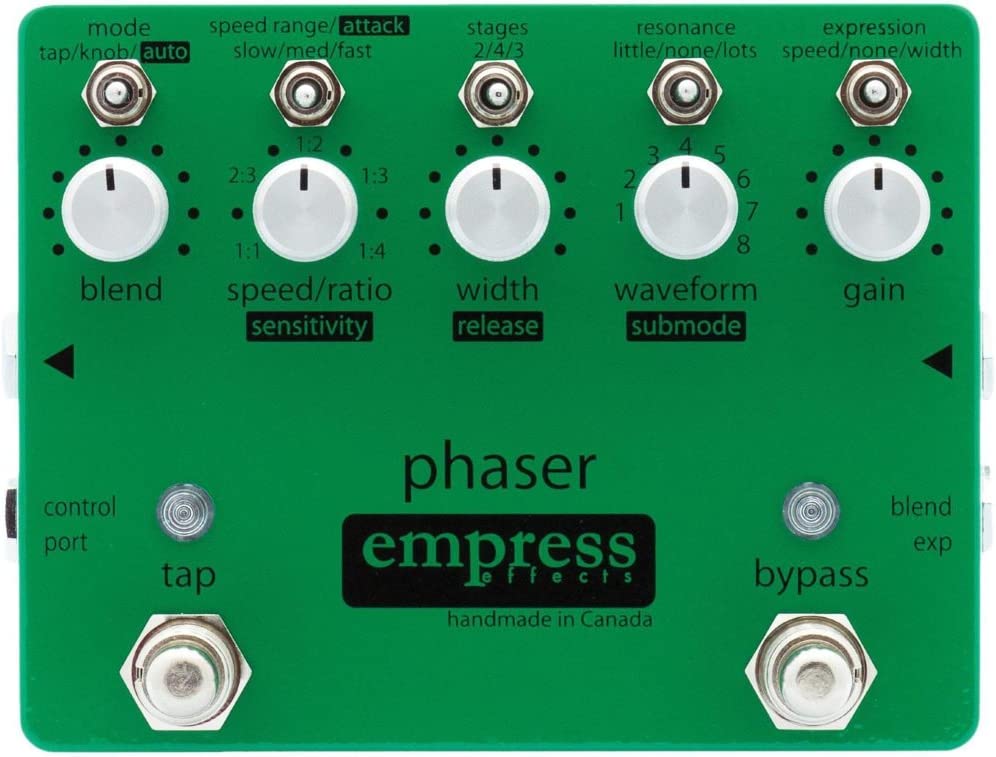
The Empress Effects Phaser Guitar Effects Pedal is an innovative guitar accessory with a green expression-style design.
It is compact, measuring 5.9 x 5.2 x 2.6 inches and weighing just over a pound.
What sets this pedal apart is its unique VCA-based design, which ensures an exceptional signal-to-noise ratio.
This phaser pedal provides multiple stage options, such as 2, 4, or a special 3-stage mode, which can be controlled through tap tempo.
Additionally, there are eight waveforms to choose from, giving users a versatile range of sounds.
A microprocessor controls its all-analog signal path, maintaining the pedal’s character while allowing for greater adaptability and control.
Besides the classic jet, auto-wah, and ring modulator sounds, this pedal stands out with its auto modes, including envelope following, audio-triggered sweeps, and rhythmic settings.
In addition, its connectivity options are impressive, supporting expression pedal control, control voltage, external tap, external audio control, and MIDI.
Housed in a durable die-cast aluminum enclosure, this pedal ensures true bypass for a clean signal.
- My Review
After spending some time with the Empress Effects Phaser Guitar Effects Pedal, I can confidently say that this phaser pedal delivers a fantastic range of tones and features, making it a valuable addition to any guitarist’s setup.
In addition, its VCA-based design ensures an impressive signal-to-noise ratio, providing a clean, high-quality sound.
One of the standout aspects of this pedal is its versatility.
I could explore various sonic textures with options for 2, 4, or even an exclusive 3-stage mode.
In addition, the tap tempo control and eight waveforms further expanded the possibilities, letting me experiment with classic jet, auto-wah, ring modulator sounds, vibrato, and Univibe tones.
The auto modes, including envelope following, audio-triggered sweeps, and rhythm settings, truly set this pedal apart from others in the market.
These unique features allowed me to achieve dynamic, expressive sounds that responded to my playing.
Connectivity options are another strong point of this pedal.
With support for expression pedal control, control voltage, external tap, external audio control, and MIDI, it’s easy to integrate the Empress Phaser into a more complex effects chain or use it with other gear.
The die-cast aluminum enclosure looks great and provides durability and protection for the pedal.
In addition, the true bypass ensures a clean signal, which is essential for any serious guitarist.
While it may take some time to familiarize yourself with all the different settings, the Empress Phaser is well worth the investment.
Its slightly higher price point might be a concern for some, but the level of control, adaptability, and sound quality it offers justifies the cost.
Here are the ratings I’ll give to the Empress Effects Phaser Pedal:
In my experience, this pedal has become an integral part of my sound, adding depth, color, and character to my guitar tone.
It’s an excellent choice for guitarists looking to expand their sonic palette with a high-quality, versatile phaser pedal.
- Pros:
- Excellent phaser tone
- Dynamic and versatile controls
- Unmatched signal-to-noise ratio
- All-analog signal path
- Auto modes for added control
- Cons:
- No negative reviews yet
My final verdict is that the Empress Effects Phaser Guitar Effects Pedal is an excellent product for guitar players who value versatility, performance, and high-quality sound.
With its unique VCA-based design, all-analog signal path, and microprocessor control, this pedal offers an impressive set of features allowing a wide range of tonal possibilities.
Customers highly praise the pedal’s lush and dynamic phaser tone, as well as its rock-solid construction and unmatched signal-to-noise ratio.
While some consider the pedal pricey, many customers feel it is well worth the investment, given its versatility and high-quality performance.
Overall, the Empress Effects Phaser Guitar Effects Pedal is a top-of-the-line product that delivers outstanding value for its price.
JOYO JF-06 Vintage Phaser Pedal
Beautifully replicates sound of phaser guitar effect of the 70’s and 80’s.
JOYO offers quality guitar effects and amplifiers, providing an innovative, hassle-free solution to enhance your guitar playing experience. Their products feature solderless installation and custom-engineered components for superior sound and performance.
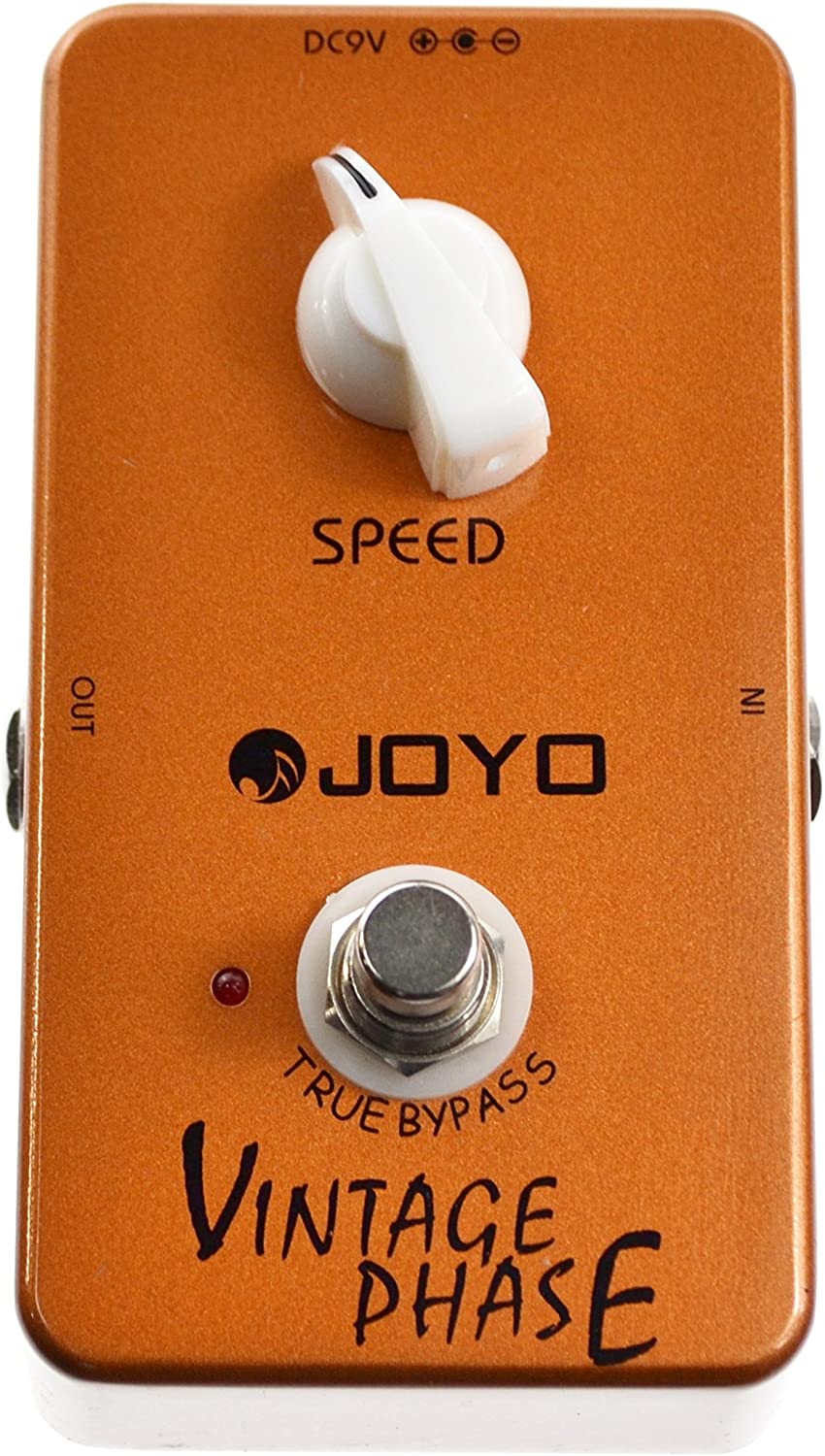
The JOYO JF-06 Vintage Phase Guitar Effect Pedal is a great choice for guitarists who want to add phaser guitar effects to their playing.
This pedal is designed to replicate the classic phaser sound from the 70s and 80s, and it does so beautifully.
It has a simple design, with just one control knob that adjusts the rate at which the phaser cycles its pulses.
This makes it easy to use and quick to make the perfect sound.
The JF-06 also has a true bypass and durable aluminum-alloy housing, ensuring that your sound remains transparent and your pedal remains protected.
In addition, the pedal runs on 9 volts DC or battery power, making it versatile and easy to use on stage or in the studio.
The JOYO JF-06 Vintage Phase Guitar Effect Pedal is an excellent choice for guitarists looking to add phaser effects to their playing.
- My Review
I had the opportunity to try out the product, and overall, I think it’s a solid choice.
One thing that stood out to me was its versatility.
It’s great for various uses, from practicing at home to performing on stage.
The features are also impressive, with multiple effects and amp models.
In terms of tone, it delivers.
The sound is clear and balanced, and I achieved a wide range of sounds thanks to the amp models and effects.
It’s also easy to adjust the settings to get the sound right.
The performance was smooth and reliable, and I had no issues with feedback or distortion.
When it comes to the brand, it’s a well-known and respected name in the industry, and I appreciate the quality of its products.
However, the value is something to consider.
While the price for the features and quality is not unreasonable, it may not be the most budget-friendly option.
One potential drawback is the size and weight.
It’s not the most portable option, which could be a downside for musicians who travel frequently.
Also, while the controls are intuitive, it takes time to understand all the settings and effects fully.
Regarding user reviews, there were some complaints about the product’s durability, but I did not experience any issues myself.
Here are the ratings I’ll give to the JOYO JF-06 Vintage Phaser Pedal:
I recommend this product to anyone looking for a versatile, high-quality amp with many effects and amp models.
While it may not be the most budget-friendly or portable option, it’s certainly a reliable and solid choice for musicians of all levels.
- Pros:
- Easy-to-use with single speed control
- Replicates classic phaser guitar effect
- Can produce subtle to extreme tones
- True bypass provides transparent tone
- Durable aluminum-alloy housing
- Cons:
- May produce hum or noise when activated
- May muddy tone when used with drive pedals
- Only one control knob for speed
- No power supply or cable included
- May not be as high quality as more expensive pedals
My final verdict is that the JOYO JF-06 Vintage Phase Guitar Effect Pedal is a great choice for guitarists looking for an affordable yet high-quality phaser pedal that can replicate classic phaser guitar effects from the 70s and 80s.
With its easy-to-use single control knob, true bypass, and durable aluminum-alloy housing, the JF-06 can deliver subtle to extreme tones and transparent sound.
However, it may produce some hum or noise when activated and may not be as high-quality as more expensive pedals.
Overall, for its price and features, the JOYO JF-06 Vintage Phase Guitar Effect Pedal is a great value and a recommended addition to any guitar player’s pedalboard.
Boss PH-3 Phase Shifter Pedal
Vintage and modern phasing with realtime control.
The BOSS PH-3 Phase Shifter pedal offers a wide range of vintage and modern phasing effects, with tap tempo and realtime expression control. New “Rise” and “Fall” modes create unique, unidirectional phasing.
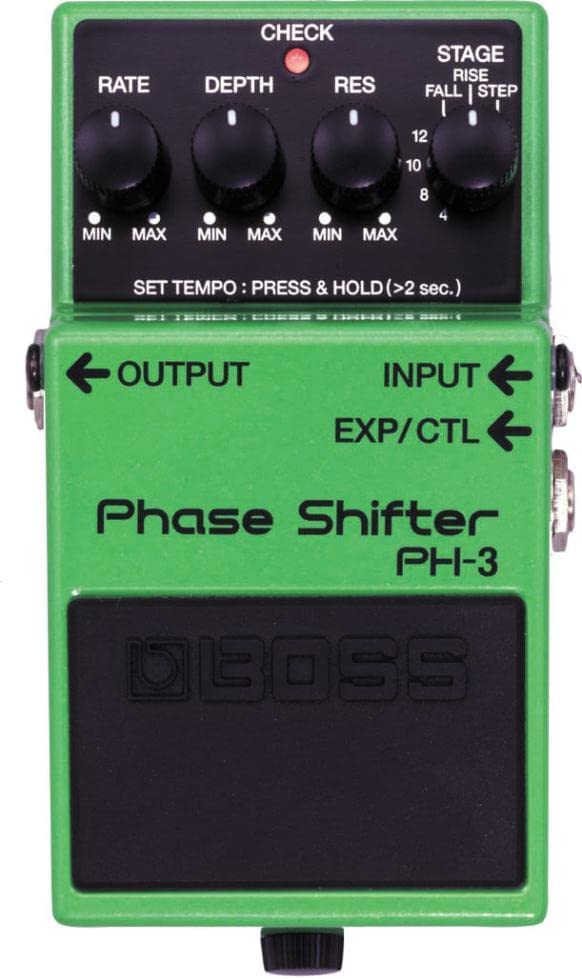
The Boss PH-3 Phase Shifter Pedal is a guitar and bass effect pedal that offers a variety of vintage and modern phasing effects.
The pedal features a knob control interface and an analog signal format.
Its unique features are the “Rise” and “Fall” modes for unidirectional phasing.
The pedal can also be synced with tap tempo and includes an optional expression pedal for real-time control over Rate, Filter, and Tempo.
This pedal is green, and its dimensions are 6 x 3.8 x 2.9 inches.
It weighs 0.46 kilograms and operates with a 9-volt voltage and 3-milliamp amperage.
While the pedal is generally well-regarded for its solid and reliable performance, some users have reported potential tone issues with bass guitars and occasional reliability issues.
Despite these potential drawbacks, the Boss PH-3 Phase Shifter Pedal remains popular for guitarists looking to add phasing effects to their sound.
Its range of vintage and modern phasing options, tap tempo synchronization, and optional expression pedal contribute to its versatility and real-time control capabilities.
- My Review
I tried out the Boss PH-3 Phase Shifter Pedal and have some thoughts on this popular effects pedal.
First, the pedal’s range of vintage and modern phasing effects is impressive, and the “Rise” and “Fall” modes add some interesting unidirectional phasing possibilities.
The pedal’s knob control interface is easy to use, and the analog signal format provides a warm, organic sound.
One of the standout features of the PH-3 is its tap tempo synchronization and an optional expression pedal, which offer real-time control over the pedal’s Rate, Filter, and Tempo settings.
I found this feature particularly useful when experimenting with different phasing effects and trying to dial in my ideal sound.
However, I did notice that the pedal seemed to hurt the low end of my bass guitar’s tone, which may concern some users.
The PH-3 performed well and held up to repeated use.
It’s a solid and reliable pedal that can add character and depth to your guitar’s sound.
That said, I did encounter a few potential drawbacks.
For one, the pedal’s green color may not be to everyone’s taste.
Additionally, some users have reported occasional reliability issues with the pedal, and the potential tone issue with bass guitars may also be a concern for some users.
Despite these potential drawbacks, I recommend the Boss PH-3 Phase Shifter Pedal to guitarists looking to expand their effects pedal collection.
Here are the ratings I’ll give to the Boss PH-3 Phase Shifter Pedal:
Its versatility and real-time control capabilities make it a great addition to any setup, and the pedal’s solid and reliable performance will satisfy most users.
While it may not be perfect for every situation, the PH-3 is worth considering if you’re in the market for a phaser pedal that can provide a range of vintage and modern phasing effects.
- Pros:
- Versatile vintage/modern phasing effects
- Optional expression pedal for realtime control
- Adjustable level of the effect
- Solid, reliable effect pedal
- Great for experimental and prog music
- Cons:
- May eat bass tone
- May lower volume/bass response
- May add noise
- Reliability issues reported by some users
- Not transparent and colors sound somewhat
My final verdict is that the Boss PH-3 Phase Shifter Pedal is a versatile and feature-packed phaser pedal that delivers a range of vintage and modern phasing effects.
In addition, the pedal’s optional expression pedal and tap tempo synchronization add flexibility and real-time control.
While some users reported issues with the pedal’s effect on bass tones and potential noise, its solid and reliable performance makes it a good investment for guitarists seeking a phaser pedal that can add character and depth to their tone.
Catalinbread Many Worlds 8 Stage Phaser Pedal
Offers 8 stage phaser with 8 selectable phase control parameters.
The Many Worlds Phaser is an eight-stage pedal offering classic swirly and rich vibrato-esque phaser sounds, as well as unique other-worldly sounds. It features 8 selectable phase control parameters, 6 LFO’s, 2 envelope-dependent phase shift modes, and a robust LFO engine. Experiment with different LFO shapes and have fun exploring the many sonic possibilities with this pedal.
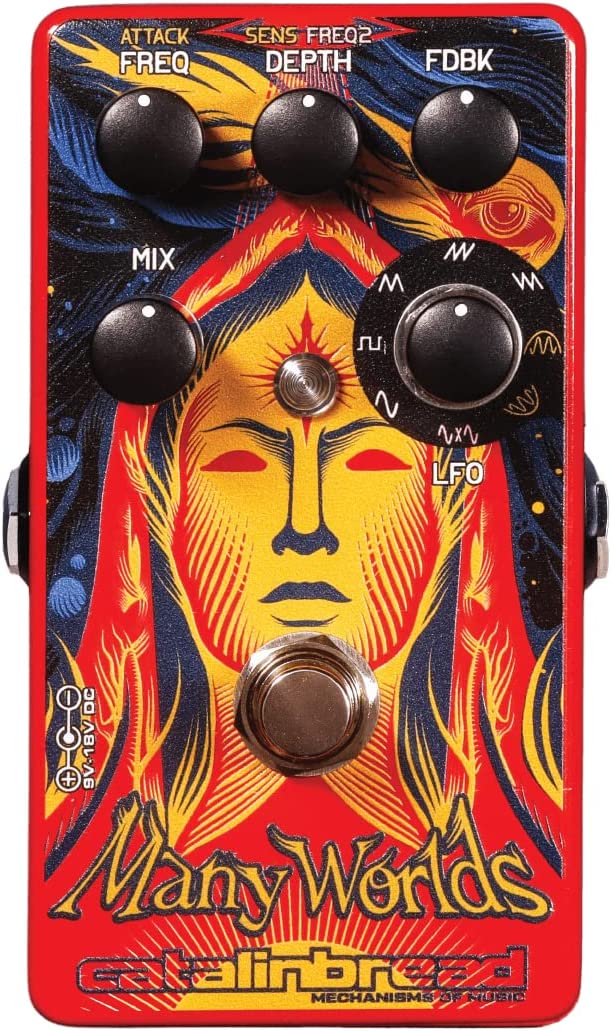
The Catalinbread Many Worlds 8 Stage Phaser is a guitar pedal that provides a versatile range of phaser effects.
The pedal features eight selectable phase control parameters, 6 LFOs, and two envelope-dependent phase shifts, which offer many customization options.
The pedal’s LFO engine includes classic sine and square waveforms and more unique options like a reverse sawtooth and two independently controlled and intermodulation sine waves.
The envelope-dependent phase shift allows the phase shift to be controlled with a pick attack, giving an autowah-esque manually controlled phase shifting experience.
The Many Worlds phaser is named after the “Many Worlds” interpretation of quantum mechanics, which influenced the development of the product’s unique LFO options.
The pedal is designed to be compact and professional-looking.
The Catalinbread Many Worlds 8 Stage Phaser is a promising option for guitarists seeking a customizable and unique phaser effect.
- My Review
After trying out the Catalinbread Many Worlds 8 Stage Phaser, I can say it is an impressive guitar pedal with many features and versatility.
The eight-stage phase provides a wide range of sounds that can be further customized with the eight selectable phase control parameters, 6 LFOs, and two envelope-dependent phase shifts.
The LFO engine is robust, with various waveform options, including unique choices like the reverse sawtooth and the intermodulation sine waves.
The envelope-dependent phase shift allows auto-wah-style phase shifting control with a pick attack.
The Many Worlds phaser gets its name from the “Many Worlds” interpretation of quantum mechanics, which influenced the development of the product’s unique LFO options.
While this may not matter to some users, it’s an interesting detail that adds to the pedal’s uniqueness.
The pedal is also well-designed, with a compact and professional appearance.
As for the sound quality, I found the Many Worlds Phaser excellent.
It has a crystal-clear and transparent effect that sounds very professional.
It’s easy to dial in classic, swirly phaser sounds, but the real fun comes with the unique, out-there effects that can be achieved with the Many Worlds settings.
Here are the ratings I’ll give to the Catalinbread Many Worlds 8 Stage Phaser Pedal:
The only downside I could find is that the price may be a bit high for some users, but I think it’s worth it for the versatility and quality of the product.
I highly recommend the Catalinbread Many Worlds 8 Stage Phaser to any guitarist looking for a customizable and unique phaser effect.
- Pros:
- Wide range of sounds.
- Unique, otherworldly effects.
- Envelope-dependent phase shift.
- 8 selectable phase control parameters.
- Robust LFO engine with 6 options.
- Cons:
- No negative reviews available.
My final verdict is that the Catalinbread Many Worlds 8 Stage Phaser is an exceptional guitar pedal that offers a lot of versatility and unique features.
The sound quality is excellent, and the customizable settings allow for a wide range of classic and out-there effects.
In addition, the LFO engine is robust, with multiple waveform options, and the envelope-dependent phase shift adds an autowah-style manual control that’s fun to experiment with.
The Many Worlds phaser is well-designed and professional-looking, which adds to its appeal.
While the price may be a bit high for some users, I believe it’s worth it for the quality and versatility of the product.
Overall, I highly recommend the Catalinbread Many Worlds 8 Stage Phaser to any guitarist looking for a high-quality, customizable phaser effect.
Whether you’re looking for classic, swirly phaser sounds or something more unique and experimental, the Many Worlds phaser delivers.
Fender Lost Highway Phaser Pedal
Powerful, flexible analog phasing with independent rate/depth controls.
The Lost Highway Phaser is a true analog pedal with switchable fast/slow speeds, 4- and 8-stage phasing, and wave toggle for versatile sound shaping. Its adjustable sensitivity control allows modulation rate changes based on your playing dynamics, while its blend and feedback controls give you full control over your sound.
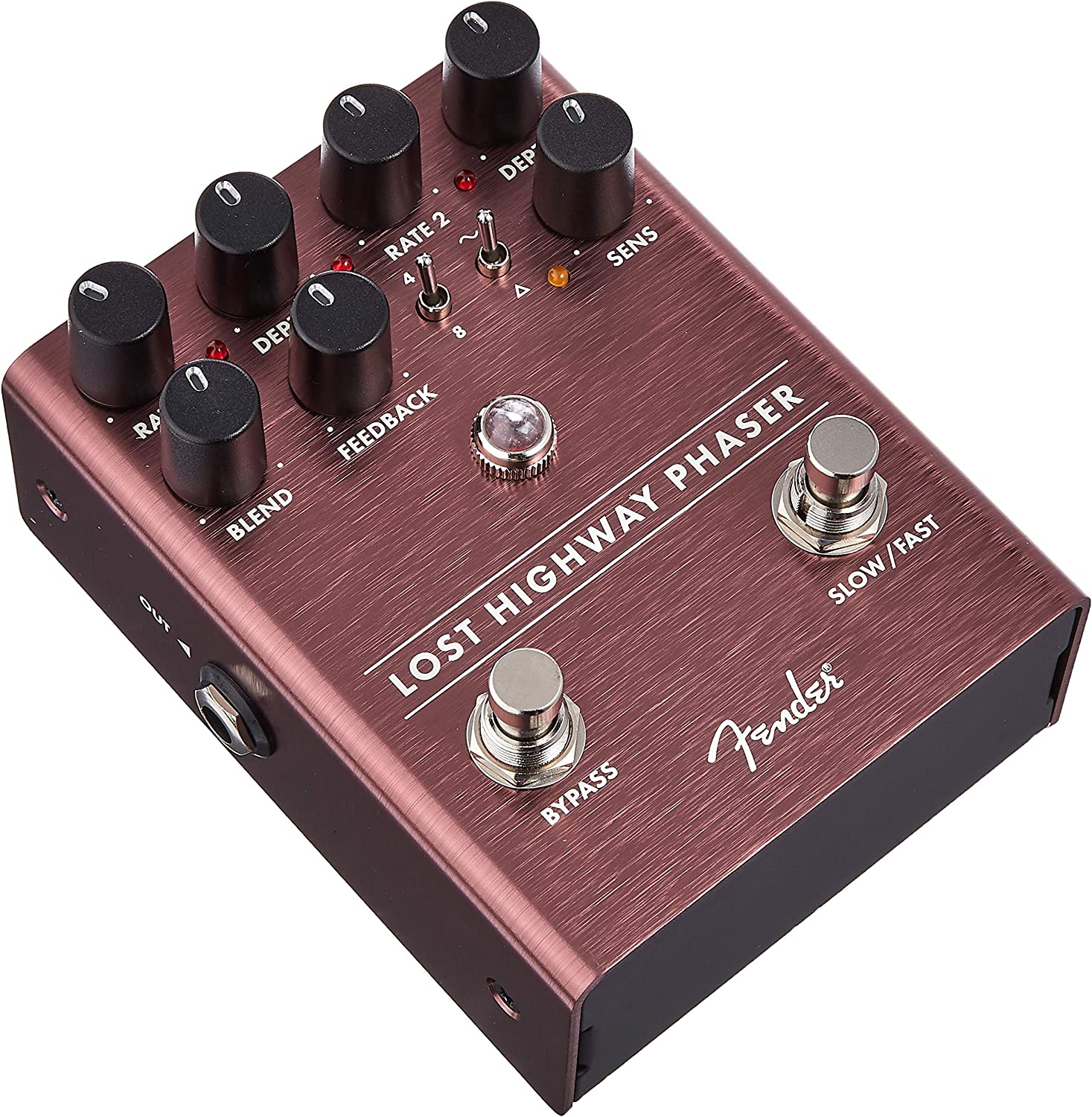
The Fender Lost Highway Phaser Pedal is an analog phaser pedal designed to add a sense of motion and dimension to your guitar sound.
It features foot-switchable fast and slow speeds with independent rate and depth controls, allowing you to easily switch between slow, moody phase shifting and rapid, warped modulation.
The wave toggle switch lets you select between sine and triangle waveforms, while the switchable 4- and 8-stage phasing allows you to add extra resonance on the fly.
The sensitivity control allows modulation rate changes based on your playing dynamics, meaning that the intensity of the phasing increases when you dig in.
This stage-ready pedal is made from lightweight, durable anodized aluminum and features LED-illuminated controls.
The Fender brand adds to its appeal, with a design inspired by vintage analog pedals but with modern controls that give you full command over your sound.
Whether a beginner or a professional, the Fender Lost Highway Phaser Pedal is a great addition to your pedalboard for adding a versatile phasing effect to your guitar sound.
- My Review
As a music enthusiast, I tried out the Fender Lost Highway Phaser Pedal, and here’s my detailed review of the product.
Starting with the positives, the pedal offers great flexibility and control over the phasing effect.
The foot-switchable fast and slow speeds with independent rate and depth controls and the wave toggle switch to select between sine and triangle waveforms make it easy to shape the sound to your liking.
The switchable 4- and 8-stage phasing also adds to the resonance of the sound, allowing for extra depth in effect.
The sensitivity control on the pedal also stands out, allowing modulation rate changes based on your playing dynamics.
This feature is particularly useful in live performances, as it adapts to your playing style, intensifying the phasing effect as you dig in.
The pedal’s design is also noteworthy, as it is made from lightweight, durable anodized aluminum with LED-illuminated controls.
This makes it easy to use on stage and adds to its aesthetic appeal.
On the other hand, there are some drawbacks to the pedal.
One downside is the rate, which may be too fast for some users, limiting the range of the slow phasing effect.
Additionally, some users have reported that the pedal feels overpriced for a product made in China, and some knobs may feel wobbly.
Here are the ratings I’ll give to the Fender Lost Highway Phaser Pedal:
In terms of tone and performance, the Fender Lost Highway Phaser Pedal delivers a decent phasing effect, but it may not be suitable for all instruments.
It is particularly useful for guitars, but other instruments may not have the same desired effect.
- Pros:
- Flexible analog phasing
- Foot-switchable Fast and Slow speeds
- Wave toggle switch to choose waveform
- Switchable 4- and 8-stage phasing
- Sensitivity control for modulation rate changes
- Cons:
- Rate may be too fast for some
- Overpriced for a pedal made in China
- Some knobs may feel wobbly
- May not work with all power supplies
- Not suitable for all instruments
My final verdict is that the Fender Lost Highway Phaser Pedal is a versatile, feature-packed analog phaser pedal with some drawbacks.
While it offers foot-switchable fast and slow speeds, independent rate and depth controls, and a wave toggle switch to choose between sine and triangle waves, it may have a rate that is too fast for some users, and some knobs may feel wobbly.
It is also relatively expensive for a pedal made in China and may not work with all power supplies.
However, it is true analog and features advanced controls, and the Fender brand and stage-ready construction add to its appeal.
I suggest this pedal to players who prioritize flexibility and features in their phaser pedal but be aware of its potential downsides.
EarthQuaker Devices Grand Orbiter V3 Phaser Pedal
Provides a diverse range of modulation and sonic exploration.
Earthquaker Devices Grand Orbiter V3 is a 4-stage OTA-based phaser pedal with a diverse range of sounds, from stationary and resonant to fast and swirly. It has a three-way switch to select different modulation speeds and a master rate control to fine-tune the speed of the LFO. It is designed and built by hand in Akron, Ohio.
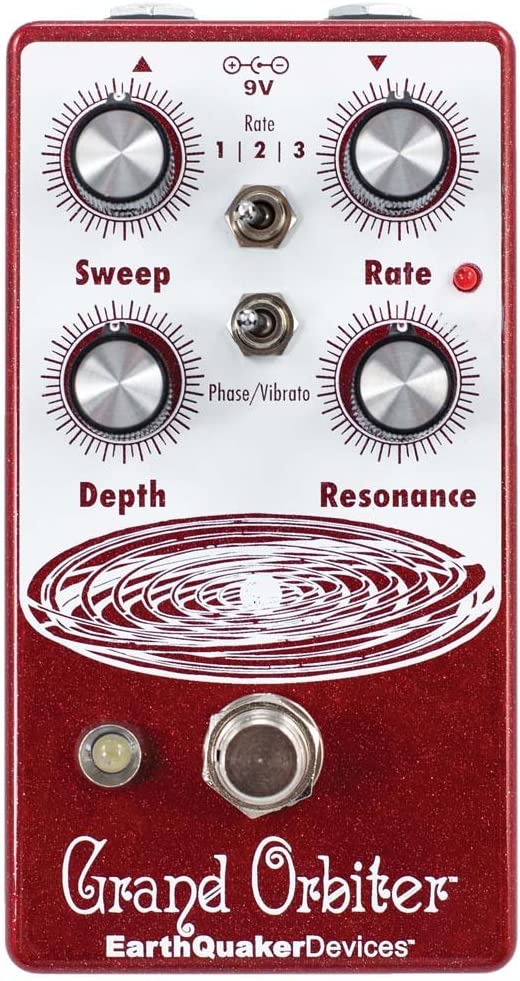
The EarthQuaker Devices Grand Orbiter V3 Phaser Pedal is a high-quality and versatile guitar effect pedal that provides a range of warm and authentic phaser tones.
Its 100% analog circuitry and true bypass design make the signal clear and transparent.
In contrast, its four-stage OTA-based phaser design provides a wide range of sounds that can be easily adjusted using depth, sweep, and resonance controls.
The pedal also features a three-way toggle switch that allows users to select between slow, fast, and fixed resonance modes, as well as a master rate control that fine-tunes the speed of the LFO in each mode.
The Grand Orbiter V3 Phaser Pedal also includes a flashing red LED, a visual indicator for effect, even in bypass mode.
So whether you’re looking for a subtle and mellow phaser tone or a fast and swirly effect, the Grand Orbiter V3 Phaser Pedal is a versatile and powerful tool that can help you achieve a wide range of sounds and textures in your playing.
- My Review
I had the pleasure of testing out the EarthQuaker Devices Grand Orbiter V3 Phaser Pedal, and I have to say, I was very impressed with its performance and versatility.
One of the things that immediately stood out to me about this pedal was its analog circuitry and true bypass design, which helped to maintain the clarity and transparency of my guitar’s signal even when the phaser effect was engaged.
The pedal’s four-stage OTA-based phaser design also provided a wide range of sounds I could easily adjust using the depth, sweep, and resonance controls.
The three-way toggle switch on the pedal allowed me to select between slow, fast, and fixed resonance modes, and the master rate control fine-tuned the speed of the LFO in each mode.
I particularly enjoyed the “vibrato” mode, which removed the dry signal and allowed me to use the depth control as a volume control.
The Grand Orbiter V3 Phaser Pedal was also very easy to use, with well-tuned and effective controls.
The flashing red LED acted as a visual indicator for effect, even in bypass mode, which was a helpful feature.
Here are the ratings I’ll give to the EarthQuaker Devices Grand Orbiter V3 Phaser Pedal:
In terms of tone, I found that the Grand Orbiter V3 Phaser Pedal provided a warm and authentic phaser sound that was well-suited for a wide range of playing styles and genres.
Depending on my needs, I could achieve a subtle and mellow phaser tone or a fast and swirly effect.
- Pros:
- 100% analog, true bypass
- Versatile and diverse feature set
- Controls are fine-tuned and effective
- Can be used as a pitch vibrato
- Works well with distortion
- Cons:
- Notch filter mode can be subtle
- May not be suitable for all music genres or playing styles
- Some reviewers had issues with shipping or received defective pedals
My final verdict is that the EarthQuaker Devices Grand Orbiter V3 Phaser Pedal is a high-quality and versatile phaser pedal with a diverse feature set and excellent performance.
Its analog circuitry, and true bypass design provide a warm and authentic tone that many guitarists will appreciate.
Its controls are effective and well-tuned for a wide range of applications.
While some reviewers have reported issues with shipping or defective pedals, the overall quality and reputation of the Earthquaker Devices brand make this pedal a solid choice for any guitarist looking for a top-tier phaser effect.
Overall, I would highly recommend the Grand Orbiter V3 Phaser Pedal to any musician seeking a versatile and high-quality phaser effect for their pedalboard.
MXR Phase 95 Mini Guitar Effects Pedal
Two iconic phase circuits in one mini housing.
The MXR Phase 95 combines the iconic Phase 45 and Phase 90 circuits in a mini housing, offering two phasing styles and familiar speed control. Its compact size and superior sound make it a great option for those looking to tighten up their pedalboard.
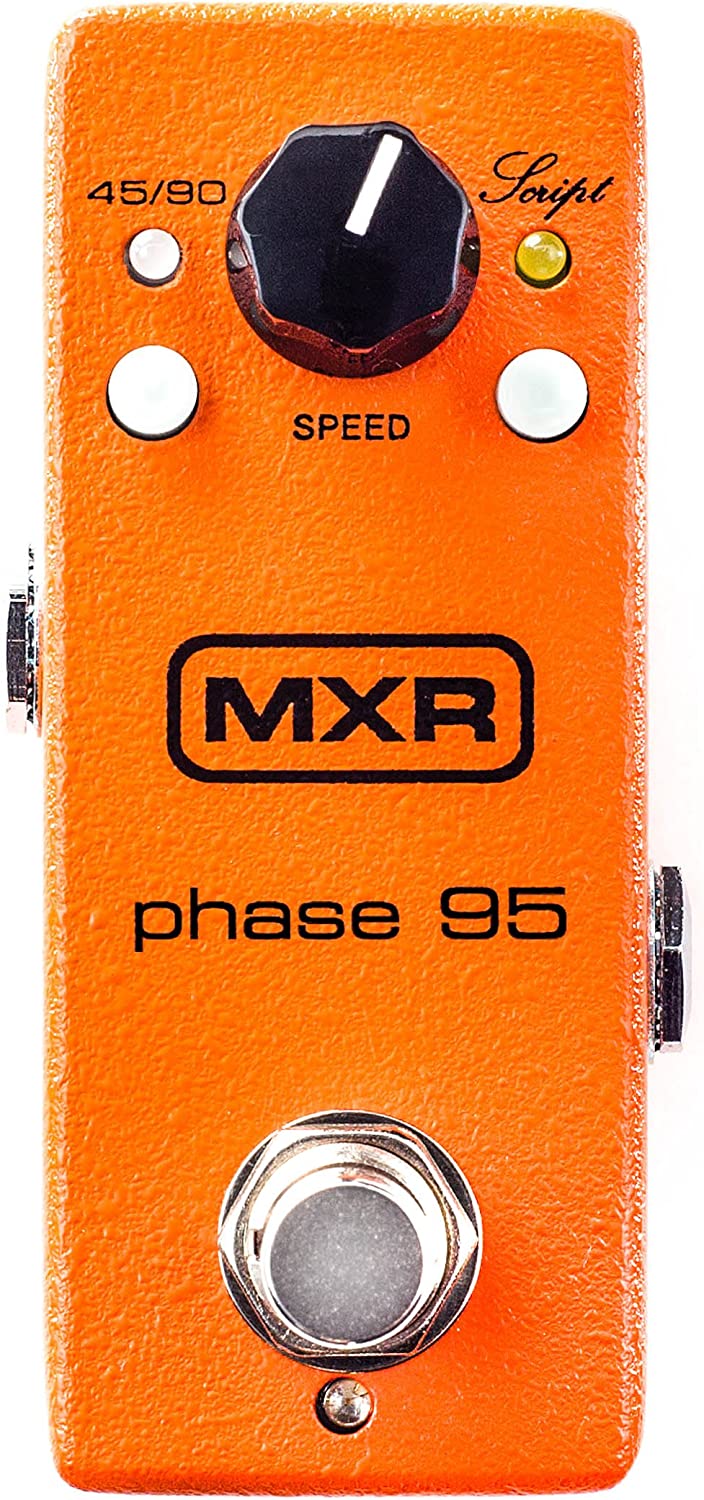
The MXR Phase 95 Mini Guitar Effects Pedal is a powerful phaser that combines two iconic circuits in one compact housing.
It features a 45/90 switch between the phase 45 mode’s subtle two-stage phasing and the phase 90 mode’s more pronounced four-stage phasing, while the script switch toggles between two phasing styles.
The pedal is set to modern-style phasing by default, which relies on feedback to create light harmonic distortion and give the effect a more accentuated swoosh.
Engaging the Script switch removes feedback for a lusher, more subdued sound with higher headroom and greater clarity.
The familiar speed control sets the rate of the effect.
The pedal has a high-quality analog signal format, ensuring that your tone stays true and unaltered.
It’s built to last, with superior construction and a refined sound that has set the standard by which all other phases are judged.
With its compact size, the Phase 95 takes up about half the footprint of a standard MXR pedal, making it an ideal addition to any pedalboard.
It’s versatile with four different phasing modes, giving you a range of tones.
While some issues with volume boost and signal leakage have been reported, most users have been very satisfied with the pedal’s performance and tone.
- My Review
As a music enthusiast, I’ve had the opportunity to try out the MXR Phase 95 Mini Guitar Effects Pedal, and I must say that it’s a versatile and high-quality phaser that packs a lot of features into a compact housing.
One of the standout features of this pedal is its ability to combine two iconic circuits in one unit.
The 45/90 switch allows you to toggle between the subtle two-stage phasing of the phase 45 mode and the more pronounced four-stage phase 90 mode.
Depending on your preference, the script switch lets you choose between modern and vintage-style phasing.
The pedal’s construction is top-notch, with its compact size taking up only half the footprint of a standard MXR pedal, making it easy to fit on any pedalboard.
In addition, the analog signal format ensures that your tone stays true and unaltered.
One of the most notable aspects of this pedal is its versatility.
It offers four different phasing modes, making it great for guitarists and keyboardists.
I particularly enjoyed using it on bass, where the different phasing styles allowed me to create a range of sounds, from subtle modulation to full-on swirling tones.
While there have been some reported issues with volume boost and signal leakage, I didn’t experience these problems myself.
I was impressed with how the pedal maintained my signal’s level when engaged, making it easy to integrate into my live rig.
Phase 95’s tone is rich and full of depth.
It’s perfect for guitarists and keyboardists looking to add a touch of phasing to their sound.
The speed control lets you adjust the effect rate, allowing for fine-tuning your tone.
Here are the ratings I’ll give to the MXR Phase 95 Mini Guitar Effects Pedal:
Regarding value, I think the MXR Phase 95 is a great investment for any musician looking for a quality phaser pedal.
In addition, it’s priced reasonably, especially considering the range of features it offers.
- Pros:
- Combines two iconic circuits in one.
- Compact size saves space on pedalboard.
- Versatile with four different phasing modes.
- High-quality analog signal format.
- Durable construction built for the road.
- Cons:
- Some users experience volume boost when engaged.
- Design flaw: pedal doesn’t turn off without unplugging.
- Signal leakage when pedal is off for some users.
- Occasional quality control issues reported.
My final verdict is that the MXR Phase 95 Mini Guitar Effects Pedal is a versatile, feature-packed, high-quality phaser pedal built to last.
It combines two iconic circuits in a compact housing and offers four different phasing modes, making it a great addition to any guitarist or keyboardist’s arsenal.
While some issues with volume boost and signal leakage were reported, most users were satisfied with the pedal’s performance and tone.
I highly recommend this pedal to anyone looking for a versatile and high-quality phaser effect.
What exactly is a phaser pedal?
A phaser pedal is an electronic device used predominantly by musicians, particularly guitarists, to modify and manipulate the sound of their instrument, creating a distinct tonal effect.
This effect, known as phase shifting or phasing, is achieved by splitting an audio signal into two identical paths.
A filter manipulates one path while the other remains unaltered.
When the two signals are combined, they create an interference pattern due to their phase differences, resulting in the characteristic swooshing or swirling sound that phasing is known for.
To appreciate the phaser pedal’s role in music, it is essential to understand the basic principles of sound and signal processing.
Sound travels in waves, each with a series of peaks and troughs.

The highest point of a wave is referred to as the peak, while the lowest point is called the trough.
On the other hand, the distance between two consecutive peaks or troughs is known as the wavelength, and the number of wavelengths that occur in one second is defined as the frequency.
The phase of a wave refers to its position in the cycle at any given time.
Phaser pedals manipulate the phase of an audio signal by employing a series of all-pass filters, also known as phase shifters.
An all-pass filter allows all signal frequencies to pass through unchanged amplitude but alters the signal’s phase at specific frequencies.
As a result, these filters introduce a phase shift that varies with frequency, causing some parts of the signal to be delayed while others remain unaffected.
Phaser pedals contain multiple all-pass filters connected in series, each responsible for introducing a varying degree of phase shift.
The overall phase shift produced by the pedal depends on the settings of each filter, which can be controlled by the musician using the pedal’s knobs or switches.
The altered signal is then combined with the original, unprocessed signal, causing the peaks and troughs of the two signals to either reinforce or cancel each other out, depending on their phase relationship.
This interaction results in the creation of notches, or regions of reduced amplitude, in the frequency spectrum of the output signal.
The settings of the phaser pedal determine the position of these notches in the frequency spectrum and can be adjusted by the user to produce different effects.
Typically, phaser pedals will include controls for adjusting the depth and rate of the phase shifting.
The depth control determines the intensity of the effect by adjusting the amount of phase shift introduced by the all-pass filters.
In contrast, the rate control modifies the speed at which the notches in the frequency spectrum move, creating a sense of motion in the sound.
The history of the phaser pedal can be traced back to the late 1960s and early 1970s when engineers and musicians were experimenting with new ways to manipulate and enhance the sound of electric guitars.
The earlier invention of the flanger inspired the development of the phaser effect, another modulation effect that creates sweeping, spatial sounds by combining a signal with a delayed version of itself.
One of the earliest and most influential phaser pedals was the Electro-Harmonix Small Stone, introduced in 1974 by Mike Matthews, founder of Electro-Harmonix.
Some notable examples include Eddie Van Halen, David Gilmour, and Jimi Hendrix.
What should you consider when choosing a phaser pedal?
When choosing a phaser pedal, there are several factors to consider to make an informed decision and find the right pedal for your musical needs.
By considering sound quality, controls, features, analog vs. digital, build quality and durability, presets and versatility, brand reputation, price and budget, reviews, and recommendations, you can better navigate the wide range of phaser pedals available on the market.
– Sound quality:
Sound quality should be a top priority when choosing a phaser pedal, as it directly impacts your music’s overall tone and character.
Listen to demos and try different pedals to understand their unique tonal qualities.
Consider the pedal’s depth, warmth, clarity, how well it fits your preferences, and the style of music you play.
Some phaser pedals may produce a subtle, smooth effect, while others may be more pronounced and intense, so finding one that complements your desired sound is essential.
– Controls and features:
Phaser pedals come with various controls and features that allow you to manipulate the effect to suit your needs.
For example, basic phaser pedals may have just one or two knobs for controlling the speed and depth of the effect.
At the same time, more advanced models may offer additional controls for feedback, resonance, or the number of stages.
Consider your desired level of control and customization when selecting a phaser pedal and whether you prefer a simple, user-friendly interface or more complex options for fine-tuning the effect.
– Analog vs.Digital:
Phaser pedals can be either analog or digital, with each type offering its distinct advantages and characteristics.
Analog phaser pedals use analog circuitry and components, which many musicians believe provide a warmer, more natural sound.
On the other hand, digital phaser pedals use digital signal processing (DSP) to create the effect, resulting in greater precision and flexibility.
In addition, digital phasers may offer more control options and preset emulate the sound of classic analog phasers.
Consider your preferences and priorities when deciding between an analog or digital phaser pedal.
– Build quality and durability:
A phaser pedal’s build quality and durability are important factors to consider, especially if you plan to use the pedal frequently or in live performances.
Look for a pedal with a sturdy, well-constructed enclosure and high-quality components to ensure that it can withstand regular use and transport.
Additionally, consider the quality of the input and output jacks and the switches and knobs, as these components can impact the pedal’s longevity and reliability.
– Presets and versatility:
Some phaser pedals offer built-in presets and the ability to save custom settings, providing a higher level of versatility for those who want to experiment with different phaser sounds.
This feature can be particularly useful for musicians who play a wide range of genres or require quick access to multiple phaser settings during live performances.
Consider whether presets and the ability to save custom settings are important when choosing a phaser pedal.
– Brand reputation:
A brand’s reputation can indicate the quality and reliability of its products.
Research well-established and reputable brands in the world of phaser pedals, such as MXR, Electro-Harmonix, and Boss, among others.
These companies have a history of producing high-quality, reliable pedals that many musicians favor.
However, don’t be afraid to explore lesser-known brands or boutique pedal makers, as they may offer unique, innovative designs that could suit your specific needs.
– Price and budget:
Phaser pedals are available at different prices, from affordable entry-level models to high-end boutique options.
Determine your budget before shopping for a phaser pedal, and consider whether you’re willing to invest in a more expensive model to achieve a specific sound or feature set.
Remember that higher-priced pedals often provide better build quality, sound, and features, but many affordable options offer great performance and value for money.
When setting your budget, consider factors such as the frequency of use, the importance of the phaser effect to your overall sound, and whether you are a hobbyist or a professional musician.
– Reviews and recommendations:
Reading reviews and seeking recommendations from other musicians can be invaluable when choosing a phaser pedal.
Online forums, social media groups, and websites dedicated to guitar gear are excellent sources of user feedback and opinions on various phaser pedals.
Remember that personal preferences and tastes can vary, so it’s important to gather opinions and try the pedal, if possible.
Consider asking fellow musicians or music store employees for their recommendations based on your specific needs and preferences.
Additionally, look for professional reviews in magazines or online publications, as they can provide a more in-depth analysis of a pedal’s features, sound quality, and performance.
How to properly use a phaser pedal?
When properly using a phaser pedal, several steps must be considered to ensure you achieve the desired sound and maximize this versatile effect.
By familiarizing yourself with the controls and features, adjusting the parameters to suit your musical goals, incorporating the phaser pedal into your signal chain, and using the effect tastefully, you can fully harness the potential of your phaser pedal and create captivating sonic textures in your music.
– Familiarize yourself with the controls and features:
Before using a phaser pedal, you must familiarize yourself with the controls and features your specific model offers.
Most phaser pedals will include knobs or switches for controlling the rate and depth of the effect.
At the same time, more advanced models may offer additional parameters such as feedback, resonance, or the number of stages.
Here are some common switches and knobs that you may find on a phaser pedal:
- Rate / Speed: This knob controls the speed of the modulation or how fast the phase-shifting effect cycles through its waveform. Turning it clockwise will increase the speed, while turning it counterclockwise will decrease the speed.
- Depth: This control adjusts the intensity of the phaser effect. Higher depth settings result in a more pronounced and dramatic effect, while lower settings produce a subtler, more nuanced sound.
- Feedback / Resonance: This knob controls the amount of output signal that is fed back into the input, which can enhance the phaser’s tonal characteristics. Increasing the feedback or resonance can produce more dramatic, sweeping sounds, while lower settings will yield a more subtle effect.
- Stages: Some phaser pedals offer a switch or knob to select the number of phase-shifting stages, which affects the overall character of the effect. More stages generally result in a more complex and richer sound, while fewer stages create a simpler, more understated effect.
- Mix / Blend: This control adjusts the balance between the dry (unprocessed) signal and the wet (processed) signal. Turning the knob clockwise will increase the amount of phaser
Take the time to explore the functions of each control and how they interact with one another to shape the overall sound of the phaser effect.
The more you know about these functions, the better and easier you will be able to experiment later on.
– Adjust the parameters to suit your musical goals:
Once you thoroughly understand the controls and features, you can adjust the parameters to achieve the desired phaser effect for your musical goals.
Start by setting the rate and depth knobs to find an appropriate balance between the intensity and speed of the effect.
Opt for a lower depth setting for a subtle, swirling sound, while a more pronounced, dramatic effect can be achieved with higher depth settings.
Experiment with different rate settings to find the perfect speed for your music, whether a slow, undulating sweep or a fast, pulsating rhythm.
If your phaser pedal offers additional controls such as feedback or resonance, adjust these settings to fine-tune the effect further, adding color and character to your sound.
– Incorporate the phaser pedal into your signal chain:
The placement of the phaser pedal in your signal chain can significantly impact the overall sound and effectiveness of the effect.
Generally, it’s recommended to place modulation effects such as phasers after gain-based effects like overdrive, distortion, and fuzz before time-based effects like delay and reverb.
This allows the phaser to interact with a more harmonically rich signal, resulting in a fuller, more defined effect.
However, there is no strict rule regarding pedal order, and you should feel free to experiment with different placements to find the one that works best for your desired sound.
-Use the phaser effect tastefully:
As with any effect, using the phaser pedal tastefully and in moderation is important to avoid overpowering your overall sound.
Consider the context of your music and how the phaser effect can enhance or complement the other elements in your mix.
For example, using the phaser sparingly can add depth and movement to clean or slightly overdriven guitar parts.
At the same time, more intense settings can create psychedelic, otherworldly textures for solos or experimental passages.
Additionally, combine the phaser with other effects, such as overdrive, delay, or reverb, to create unique and interesting soundscapes that can elevate your music.
How to order pedals on a pedalboard?
There is no one-size-fits-all approach to ordering pedals on a pedalboard, as the optimal arrangement largely depends on the specific sound you’re aiming for.
Usually, though, you will see guitar players mostly agreeing with this order:
Tuner > Filters/Dynamics > Pitch-based Effects > Overdrive/Distortion > Modulation > Time-based Effects > Looper
Aside from that, some general guidelines can help you achieve a balanced and versatile setup.
Let’s talk in detail about the order we just mentioned, but feel free to experiment and adjust to your own preferences:
- Tuner: Place your tuner pedal first to ensure your signal is in tune before passing through the other pedals.
- Filters and dynamics: Wah-wah, envelope filters, compressors, EQs, and noise gates should come next. These pedals affect your sound’s dynamic and tonal aspects, so it’s best to place them early in the chain.
- Pitch-based effects: Octavers, harmonizers, and pitch shifters should come after filters and dynamics since these pedals alter the pitch of your signal and work best with a clean, unprocessed sound.
- Overdrive and distortion: Overdrive, distortion, and fuzz pedals typically come next. They shape your guitar’s core sound, and placing them before most other effects ensures that those effects receive a strong, consistent signal.
- Modulation effects: Chorus, flanger, phaser, and tremolo pedals should be placed after overdrive and distortion effects. We do this to allow these pedals to add depth and movement to your sound without becoming overly distorted or overbearing.
- Time-based effects: Delay and reverb pedals should be placed towards the end of your signal chain. This allows them to create a sense of space and depth around the other effects, simulating the sound of a room or hall.
- Looper: If you use a looper pedal, it should be placed last in the chain. This ensures that you’re looping the entire signal, including all the effects you’ve applied.
Remember, these are just general guidelines and what generally works and sounds good.
The most important thing is to experiment and find the arrangement that best suits your personal sound and style.
For example, here’s one pedalboard signal chain that I always use:
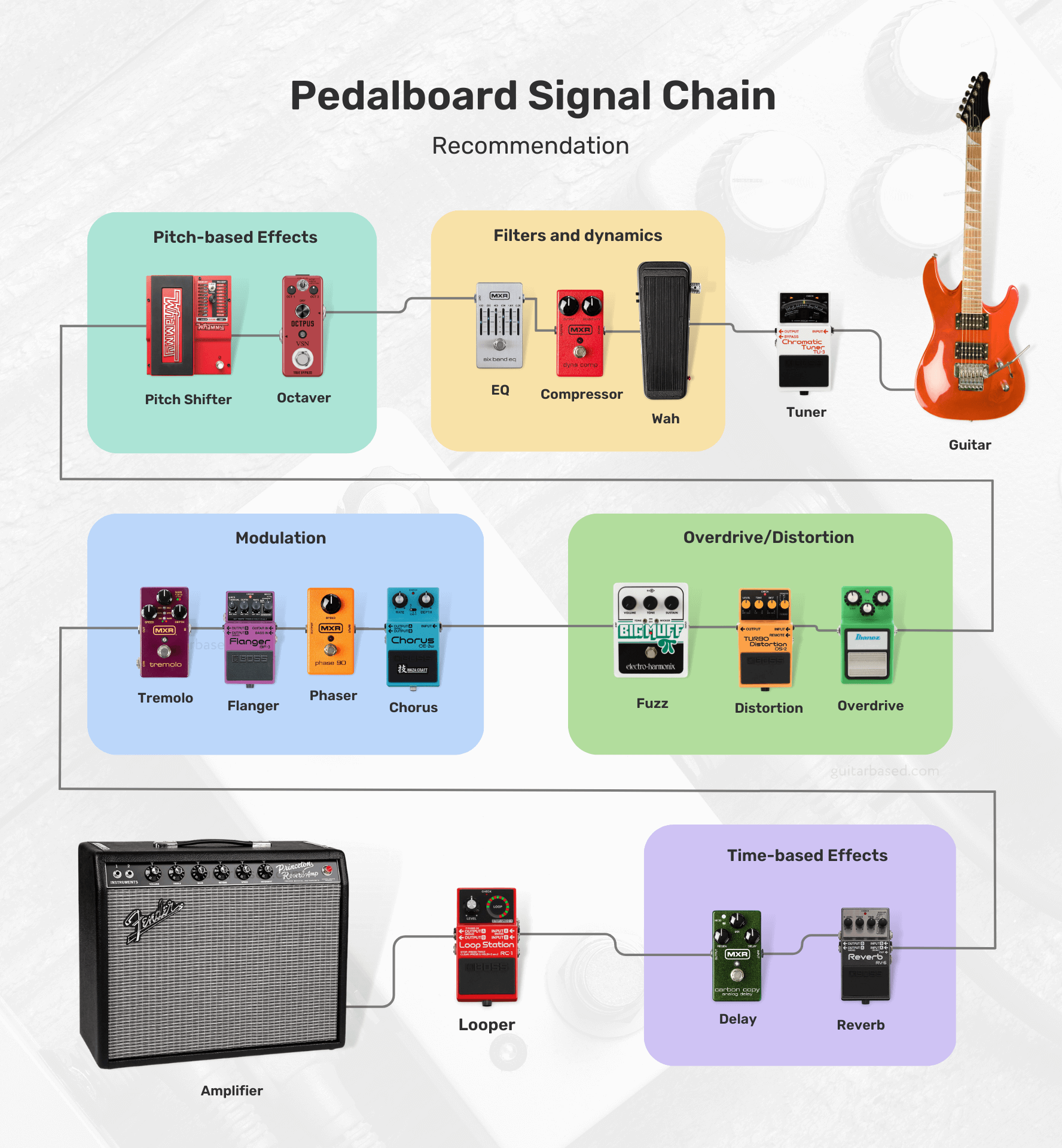
Feel free to swap the order of pedals, try different combinations, and test out unconventional setups until you find the one that works best for you.
For those interested, I’ll leave you with most of the possibilities that you’ll encounter and how to order them.
- Tuner
- Filters/Dynamics:
- Volume
- Wah
- Auto-Wah
- Compressor
- Noise Gate
- EQ (Equalizer)
- Pitch-based Effects:
- Octaver
- Harmonizer
- Pitch Shifter
- Overdrive/Distortion/Fuzz:
- Boost
- Overdrive
- Distortion
- Fuzz
- Modulation:
- Chorus
- Phaser
- Flanger
- Univibe
- Vibrato
- Tremolo
- Time-based Effects:
- Delay
- Echo
- Reverb
- Synth/Bitcrusher:
- Synth
- Bitcrusher
- Acoustic Simulator
- Multi-Effects
- Utility:
- Buffer
- A/B/Y Switcher
- MIDI Controllers
- Looper
Boutique vs. Mass-Produced pedals
Boutique pedals are generally built with higher-quality components and craftsmanship, resulting in better durability and longevity.
These pedals often feature unique and innovative designs, providing a wider range of tones and effects that may not be available in mass-produced options.
Here are a few examples of boutique pedals:

All the manufacturers also tend to have a more personal approach, with better customer service and the ability to customize pedals according to the user’s preferences.
However, boutique pedals are usually more expensive due to the smaller scale of production and the use of premium components.
Mass-produced pedals, on the other hand, are more affordable due to their larger scale of production and the use of cost-effective components.
These pedals are widely available and offer a range of popular effects, making them accessible to a larger audience.
Here are a few examples of mass-produced pedals:

The quality control for mass-produced pedals can vary depending on the brand and model, but many are reliable and offer good value for the money.
As for one of the downsides, you’ll find that mass-produced pedals may not have the same level of uniqueness or innovation as boutique options.
On the other hand, they may not provide the same level of customer service or customization options.
The choice between boutique and mass-produced pedals depends on your personal preferences, budget, and desired sound.
If you’re looking for unique tones, higher-quality components, and a more personal experience, boutique pedals may be the way to go.
But I would say, for those who are on a budget and need access to popular effects, mass-produced pedals might be a better fit.
It’s worth trying out both types to see which best suits your needs and playing style.
How much should you spend on a guitar pedal?
If I were in your position, I would first determine my budget and specific needs before deciding how much to spend on a guitar pedal.
For beginners, it might be more reasonable to start with affordable, mass-produced pedals to explore different effects without spending too much.
Guitar pedals can range in price from around $30 to over $400, depending on the brand, quality, and complexity of the effect.
As your skills and understanding of your preferred tone develop, you can gradually upgrade to higher-quality or boutique pedals.
One thing I would do is consider which effects are essential to your playing style and prioritize purchasing those first.
Allocating a larger portion of your budget to the most important pedals might be a wise choice, especially if you only need a few basic effects.
However, if you require a wide array of effects, you may want to consider more budget-friendly options or multi-effects units.
Keep in mind that higher-priced pedals often come with better build quality, unique features, and improved sound quality.
But I would also say that price is not always directly correlated with quality or suitability for your needs.
Sometimes, a more affordable pedal can deliver the exact sound you’re looking for, while a higher-priced option might not meet your expectations and are only expensive because of the brand reputation.
Can you use a guitar pedal with a bass guitar?
You can certainly use a guitar pedal with a bass guitar.
But it’s crucial to be aware that some guitar pedals may not be specifically designed to accommodate the frequency range of a bass guitar.
This could result in a less-than-ideal performance or an altered tone that might not be what you were expecting.
If you’re feeling adventurous and eager to experiment with your sound, don’t hesitate to connect your guitar pedals to your bass guitar.
This can be a fun way to explore different sonic possibilities, and you might even stumble upon some unique tones that complement your playing style perfectly.
Using a guitar pedal with a bass guitar may not always produce the desired results.
In some cases, the low-end frequencies might be lost, or the effect could sound too harsh or muddy.
To avoid these issues, you could consider looking into pedals that are specifically designed for bass guitars.
These pedals are engineered with the bass frequency range in mind, ensuring that your low-end remains intact and the effect sounds as intended.
In addition to bass-specific pedals, there are also multi-effects processors and pedals that cater to both guitar and bass players, offering a wide range of effects and tonal options.
These versatile units can be a great solution if you play both instruments and want a single device to cover your needs.
How to properly power your pedals?
When it comes to powering your pedals, you want to make sure you’re doing it right to avoid any noise issues or potential damage.
First, check each pedal’s power requirements, which you can usually find in the manual or on the pedal itself.
You’ll want to pay attention to the voltage (usually 9V, 12V, or 18V) and current (measured in milliamps or mA).
Now, you’ve got a few options for powering your pedals.
You can use individual power supplies or batteries for each pedal, but that can get messy and inconvenient.
I’d recommend going for a pedal power supply or an isolated power brick.

For example here are a few ones I recommend:
- Voodoo Lab Pedal Power 2 Plus Isolated Power Supply (My favorite)
- Rowin PW-1 Guitar Pedal Power Supply (Cheapest)
These babies can power multiple pedals at once, and the isolated outputs help prevent noise and ground loop issues.
Just make sure the power supply you choose can handle the voltage and current requirements of all your pedals.
When you’re connecting everything, use good quality power cables and keep them neat and tidy to avoid a tangled mess.
You might even want to use cable ties or cable organizers to keep everything in order.
In love with guitars, and gear; expert in all things music! Been writing about guitars for about 5 years and counting. Born in the ’90s. Alma Mater: University of Havana. Always curious, trying to understand the world. #TeamFender

